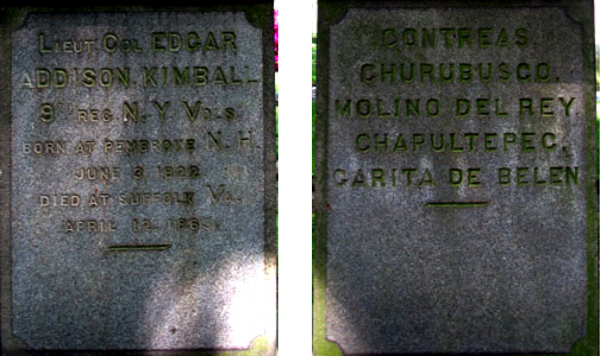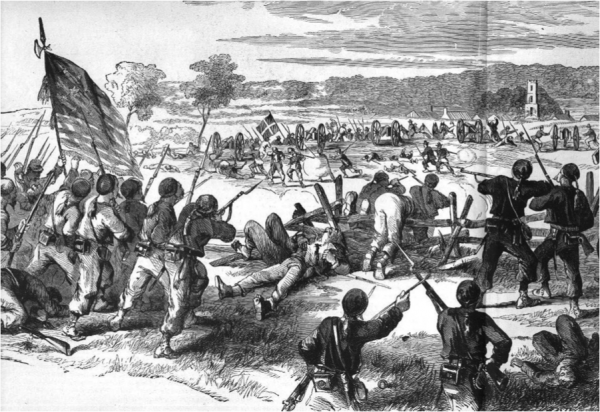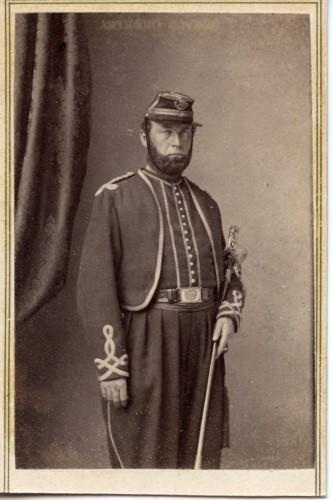JOINER, EDWIN (or EDWARD) ALFRED HANCOCK (1846-1875). Seaman, United States Navy. Born in New York City, Joiner grew up in West Farm in Westchester, New York. He mustered into the United States Navy on May 24, 1862, and re-enlisted at the New York Rendezvous on September 23, 1863. He served onboard the USS Crusader and contracted tuberculosis which ultimately caused his death.
Civil War Bio Search

When his widow, Emma Bragaw, applied for a pension and certified under certificate 4,454, several of his fellow crew testified as to his poor health. Peter McGinnis swore in an affidavit of December 11, 1893, in support of her pension application, that Joiner always complained of being cold, suffered from bronchitis during his time on the Crusader, was taking medicine, and was given strict orders by the doctor to stop washing the decks because so many men were getting sick. James Lonergan testified on February 25, 1896. He recalled that about September 1864, when the Crusader was near Yorktown, Virginia, and Fortress Monroe, Joiner looked sick and there was talk that he had consumption. He recalled that Joiner had been on the sick list, always wore a handkerchief around his throat, and did not wash his clothes one morning because he was sick and was being punished for it. Eventually, in 1875, he succumbed to tuberculosis. Section 131, lot 33275.
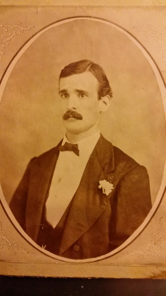
JOLLY, WILLIAM (or PETER) F. (1834-1886). Private, 11th New York Infantry, Company F. Jolly, who was born in Holland, enlisted at New York City as a private on April 20, 1861. On May 7, he mustered into Company F of the 11th New York from which he deserted on December 29, 1861. His last known address was 303 West 30th Street, Manhattan. He died of nephritis. Section 157, lot 15015.
JONES, ALEXANDER (1832-1906). Corporal, 128th New York Infantry, Company F. A New York native, Jones was a resident of Pawling, New York, when he enlisted there as a private on August 19, 1862, and mustered into the 128th New York the next day. He was promoted to corporal on October 10, 1863, and mustered out on July 12, 1865, at Savannah, Georgia. In 1893, his application for an invalid pension was granted, certificate 966,498. He was a member of the Cushing Post #231 of the G.A.R.; as per his obituary in the New York Herald, members of the post were invited to attend his funeral. His last address was 84 Bay 25th Street in Bensonhurst, Brooklyn. His death was attributed to myocarditis. Section 207, lot 32113, grave 4.
JONES, CHARLES A. (1841-1870). Sergeant, 48th New York Infantry, Company E. Jones enlisted as a private at Brooklyn on August 27, 1861, and mustered into the 48th New York the same day. He re-enlisted on December 22, 1863, and was promoted to the ranks of corporal and sergeant (April 20, 1865) before mustering out at Raleigh, North Carolina, on September 1, 1865. Cemetery records indicate that he died of an abscess. Section 115, lot 13536 (Soldiers’ Lot), grave 16.
JONES, CHARLES E. (1840-1862). Unknown soldier history. Born in England, his death in Newport News, Virginia, on February 11, 1862, is listed as a casualty of the War. Section 126, lot 2458, grave 1266.
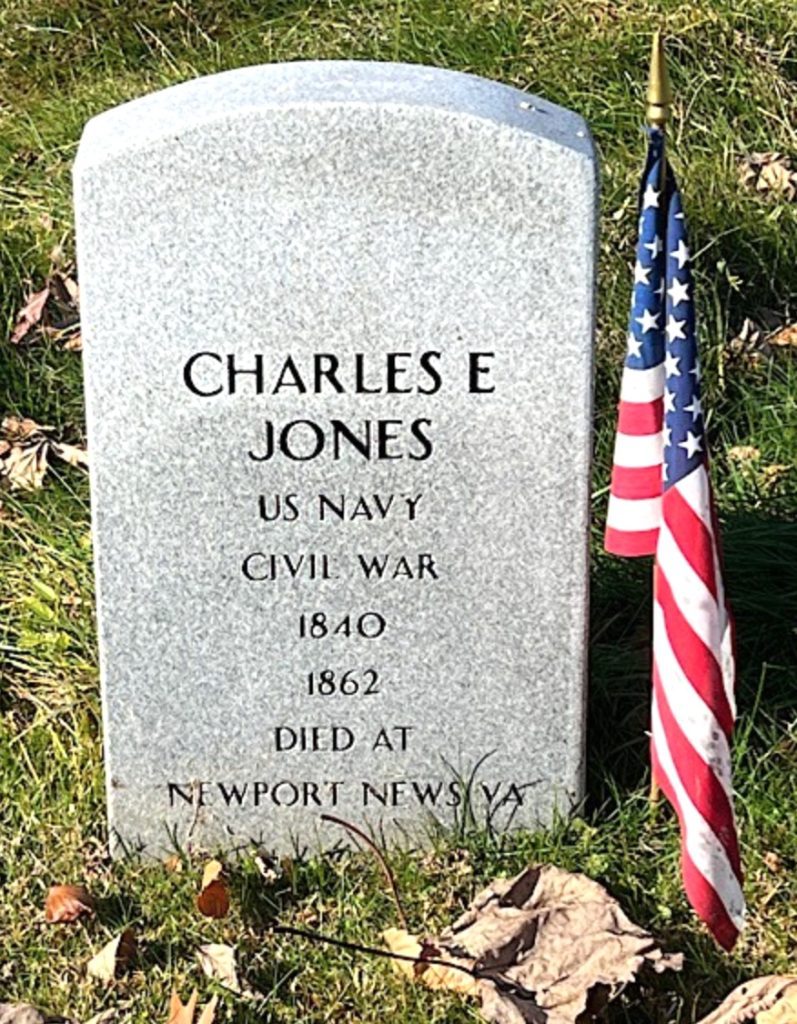
JONES, DAVID S. (1836-1911). Captain, 13th Regiment, New York State Militia, Company E. On April 23, 1861,Jones enlisted as a captain at Brooklyn. Commissioned into Company E of the 13th New York State Militia on May 17, 1861, he mustered out at Brooklyn on August 6, 1861. In 1900, he applied for and was granted an invalid pension, certificate 1,094,357. He resided in Brooklyn prior to his death from cancer in Miami. Section 166, lot 25140.

JONES, FREDERICK T. (1839-1891). Captain, 90th New York Infantry, Companies F, A, and C. Of English birth, Jones enlisted as a sergeant and mustered into Company F at Brooklyn on November 10, 1861. During his service, he was promoted to sergeant major and second lieutenant on January 1, 1863, transferred to Company A on October 6, 1863, promoted to first lieutenant on December 1, 1864, to captain on February 4, 1865, and transferred to Company C on July 21, 1865. He mustered out on February 9, 1866, at Savannah, Georgia. His last residence was on Rodney Street in Brooklyn. His death was caused by pneumonia. Section 17, lot 17245, grave 1957.
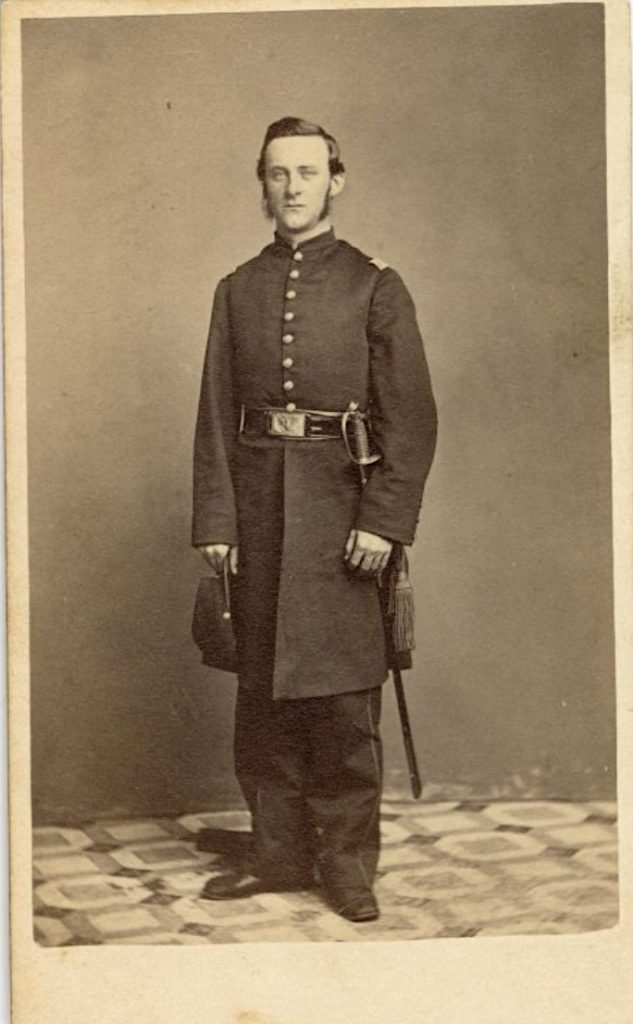
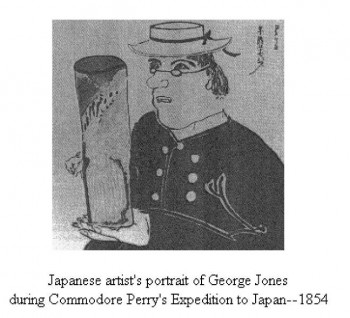
JONES, GEORGE (1800-1870). Chaplain, United States Navy; volunteer nurse. A native of York, Pennsylvania, and a Yale graduate in 1823, Jones was an educator of civilian students and military cadets, a man of God, an amateur scientist, and a prolific writer of accounts of his experiences in the Navy. He shipped as schoolmaster teaching navigation aboard the frigate Brandywine in 1825, under Commodore Charles Morris. After returning to the states and Yale in 1828, he was ordained an Episcopal minister two years later, and made rector of the church in Middletown, Connecticut. After spending a year in Indiana, he returned to the sea where he became a Navy chaplain serving on several ships, about which he wrote, Sketches of Naval Life (1829) and Excursions to Cairo, Jerusalem, Damascus and Balbec (1836).
He served as chaplain at Washington Naval Yard, and in 1845, when Annapolis was opened, was chosen as one of the eight faculty members of the first academic board. This was appropriate since his letter to the Secretary of the Navy in 1839, finding fault with the inadequacy of the then current shipboard instruction of young naval officers, was instrumental in the creation of the Naval Academy. At Annapolis, he taught English, was appointed the Academy’s first chaplain in 1851, was responsible for administering the ethics education of the seamen, and earned a reputation as one of the truly outstanding chaplains serving in the Navy. In 1853, Jones joined Matthew C. Perry’s historic expedition to open commercial relations with Japan and was a major contributor to the three-volume report of the expedition. He spent much of his two-year trip with Perry making 328 drawings of the mysterious zodiacal light, the glow in the sky seen just after dusk or before dawn, which is caused by light from the hidden sun reflecting off tiny dust particles in space. In 1857, he resumed his position as chaplain at the Naval Academy until he retired from the Navy in 1862. During the Civil War, he served as a volunteer nurse and chaplain at local hospitals. Jones was serving as chaplain at the U.S. Naval Asylum in Philadelphia, Pennsylvania, when he died from phthisis pulmonalis in 1870. Section 109, lot 13888.
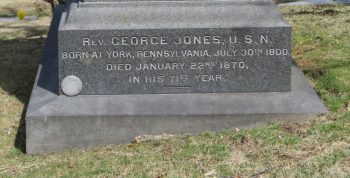
JONES, HARRISON HERTON (or HESTON) (1826-1889). Sergeant, 8th Regiment, New York State Militia, Company B. Born in New York City, Jones served as a sergeant with the 8th Regiment for three months in 1861. He applied for an invalid pension, application 508,947, but there is no certificate number. He last lived in Belmar, New Jersey. His death was caused by gastric fever. In 1890, Harriet Jones, who is interred with him, applied for and received a widow’s pension, certificate 314,292. Section 85, lot 6011.
JONES, JEPTHA A. (1824-1881). Captain, 139th New York Infantry, Company G; first lieutenant, 84th New York (14th Brooklyn) Infantry, Company D. Born in Paterson, New Jersey, Jones was a compositor as per the Brooklyn Directory of 1858. During the Civil War, he enlisted at Brooklyn as a first lieutenant on May 18, 1861, and on May 23 was commissioned into the 14th Brooklyn. Wounded at the First Battle of Bull Run, Virginia, on July 21, 1861, he was discharged for wounds on September 7, 1861. On September 6, 1862, he re-enlisted at Brooklyn as a captain, mustered into Company G of the 139th New York Infantry three days later, and was discharged on November 14, 1863. He was working as a compositor according to the Brooklyn Directories of 1863, 1865, 1866, and 1868. His last residence was on Madison Street in Brooklyn. The cause of his death was apoplexy. Section 203, lot 26354.

JONES, JOHN T. (1846-1916). Unknown soldier history. Jones was a veteran of the Civil War and a member of the G.A.R. Further details of his military service are not known. He last lived at 474 Bergen Street in Brooklyn. He succumbed to cirrhosis of the liver. Section 78, lot 3577.
JONES, JOSEPH B. (1823-1905). Surgeon, 176th New York Infantry; 52nd Regiment, New York State National Guard. A native of Manhattan, Jones was a teacher of physical education as per the census of 1850. While attending Columbia Medical School, he taught physical education at a gymnasium that he opened in Brooklyn Heights at the corner of Pineapple and Fulton Streets. In an ad for the gym that appeared in the Brooklyn Daily Eagle, he championed exercise, “Our people do not seem to understand the importance of these exercises, and they are therefore rather neglected. Whoever takes them regularly, may bid defiance to consumption and all its handmaids. They develop the chest and limbs, give firmness to the muscle, and send a glow of ruddy health over the cheek. Sedentary men, go and try them.” His gym was open to men and women, a first of its day, although the classes were separated by gender. The Reverend Henry Ward Beecher (see) and other prominent preachers endorsed his venture. His advocacy of physical education was congruent with his ardor for the Muscular Christianity movement, which held that exercise and physical health were positive Christian values and not a distraction from religion. In 1855, he joined the staff of the Brooklyn City Dispensary, Brooklyn’s first public hospital. He was the Dispensary’s first medical director, a position he held until his death. Before and during the Civil War, Dr. Jones was active in the Union League, an association that raised money for poor families whose heads of household were away at war. In 1860, he was also the president of the Excelsiors and the National Association of Base Ball Players, consistent with his belief that participation in sports was necessary for good public health. He was unsuccessful in persuading the latter organization to donate to the Union League.
Jones heeded the call to serve during the Civil War. After enlisting as a surgeon at Brooklyn on October 11, 1862, he was immediately commissioned into the 176th New York Infantry. Nine days later, he transferred into the 52nd Regiment, New York State National Guard, and mustered out on December 22, 1862. He re-enlisted as a surgeon at Brooklyn on June 14, 1863, was commissioned into the Field and Staff of the 52nd Regiment five days later, and mustered out at Brooklyn on July 25, 1863. After the Civil War, he was elected coroner as a Democrat and was appointed Brooklyn’s public health officer. In that position, he addressed the cholera epidemic of 1866 through aggressive health inspections, and cleaning up dirty streets, tenements and vacant lots. He later became superintendent of the Board of Education’s truancy department. He participated in old timers’ baseball games well into his fifties, was an accomplished boxer and billiard player and won the Union League bowling tournament in 1898. He last lived at 372 Carleton Avenue; he also had a summer home in the Adirondacks. Section 35, lot 25084.
JONES, WILLIAM (1816-1863). Unknown soldier history. Jones was born in New York. Other than the fact that he was killed in battle at Vicksburg, Mississippi, on June 27, 1863, the details of his soldier history are not known. Section 56, lot 5852.
JONES, WILLIAM C. (1846-1912). Unknown soldier history. Of English origin, the details of Jones’s military career are unspecified. According to his obituary in The New York Times, “He was a Civil War veteran and served with distinction at Gettysburg.” In civilian life, he was employed as a customs broker, was a member of the Kings County Republican General Committee, and published a paper related to sports. He last lived on 50th Street and 17th Avenue in Brooklyn. Cancer was the cause of his death. Section 36, lot 14654.
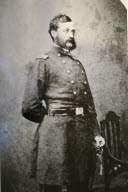
JONES, WILLIAM PRICE (1815-1869). Brigadier general by brevet; military provost marshal, Middle Department; major and additional aide-de-camp. Born in New York City and a commission merchant and auctioneer by trade, Jones served as an aide-de-camp on the staff of Major General John E. Wool from April 24 through September 10, 1861, when he was promoted to major and additional aide-de-camp. He was also provost marshal in the Department of Virginia and military provost marshal of the Middle Department. He resigned on December 29, 1862. On March 13, 1865, he was brevetted brigadier general “for gallant and meritorious services.” Jones died of paralysis in Hartford, Connecticut. Section 139/P, lot 16238.
JOOST, JOHN H. (1840-1882). Lieutenant colonel and major by brevet; captain, 38th United States Colored Infantry (USCT); private, 9th New York Infantry, Company K; 3rd New York Infantry, Company I. Joost was born in Brooklyn. After enlisting as a private at New York City on September 29, 1862, he mustered into Company K of the 9th New York the next day. As per his muster roll, he was a bank teller who was 5′ 6″ tall with blue eyes, brown hair and a fair complexion. He was transferred into Company I of the 3rd New York on May 6, 1863. On March 1, 1864, he enlisted as a captain and was commissioned into Company B of the 38th United States Colored Troops. He was brevetted to major and lieutenant colonel on March 13, 1865. He resigned on April 26, 1865. As per the 1870 census, he was living in Brooklyn with his mother and sister and working as a bank clerk. He last lived at 419 Bedford Avenue in Brooklyn. His death was caused by paralysis. Section 59, lot 1321.
JORDAN, FREDERICK (1832-1863). Private, 84th New York (14th Brooklyn) Infantry, Company F. Jordan, the younger brother of lieutenant colonel Robert B. Jordan (see), also of the 14th Brooklyn, enlisted on August 13, 1862, as a private, and mustered in the next day. Another brother, James (see), also served in the same regiment. Frederick Jordan died of disease (consumption) on September 17, 1863, in Brooklyn. The following obituary appeared that day in the local newspaper:
In this city, at 1 1/2 o’clock this morning, of consumption, Frederick, son of James and Mary Ann Jordan, aged 31 years. JORDAN- Frederick, a member of Co. F., Fourteenth Regiment, N.Y.S.M., died this morning at his residence No. 484 Atlantic st. Mr. Jordan entered the ranks of the ‘Fourteenth’ at a time when its members had been greatly depleted by succession of battles and skirmishes following the repulse of the Army of the Potomac under Pope a year ago. In August a force of recruits were sent to the regiment and among them was the deceased. The campaign in Maryland ensued and at the battles of South Mountain, Antietam, and Crampton’s Gap the Fourteenth added to the luster of its all ready established fame. It was during this severe campaign, that Mr. Jordan, with others of like unhardened constitutions having a just changed the comforts of home for privations of the life of a soldier in the field, contracted consumption, which after a year of gradual but certain progress, has numbered him with the fallen heros of the Fourteenth Brooklyn Regiment. The deceased is a brother to Lieut.-Col. Jordan of this regiment, who has been connected with it since it entered the service in May, 1861. His age was thirty-one. The time of the funeral will be published tomorrow.
His last residence was 484 Atlantic Avenue, Brooklyn. Section 186, lot 19228.

JORDAN, JAMES H. (1838-1874). Captain, 84th New York (14th Brooklyn) Infantry, Company F. A broker, he lived in New York City his entire life. Jordan enlisted as a second lieutenant on April 18, 1861, was commissioned into Company F on May 23, and discharged on August 2. The following year, he was promoted to captain and commissioned again into Company F on September 29, and served until his discharge on January 13, 1863. His brother, Frederick (see), also served with the 14th Brooklyn. In 1871, he was elected first vice president of the War Veterans’ Association of the 14th Regiment. He died from an overdose of opium. He was living at 208 Dean Street in Brooklyn at the time of his death. After his death, his widow, Louisa Jordan, married his brother, Robert (see). Section 186, lot 19228.
JORDAN, RICHARD M. (1838-1914). Private, 82nd New York Infantry, Company G. Born in New York, he enlisted there and mustered into the 82nd New York on September 1, 1861, and was discharged for disability on December 10, 1862, at Washington, D.C. Jordan’s last address was 65 West 70th Street in Manhattan. Section 178, lot 12569.
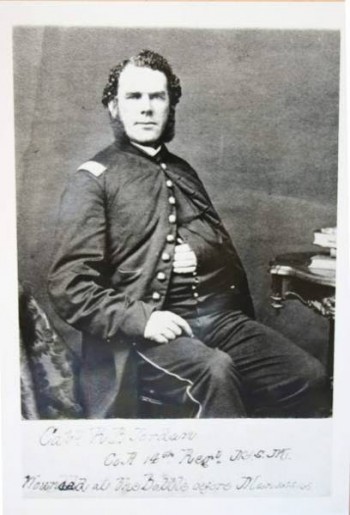
JORDAN, ROBERT B. (1826-1878). Lieutenant colonel, 84th New York (14th Brooklyn) Infantry, Company A. Born in Norfolk, Virginia, Jordan moved to New York when he was two years old. Jordan enlisted as a captain on April 18, 1861, at Brooklyn, and was commissioned into Company A of the 14th on May 23. As per his muster roll, he was 5’10”, 235 pounds, and had a florid complexion. He commanded Company A of the 14th in Virginia at the Battle of First Bull Run, July 21, 1861, where he was hit by a musket ball in the left side; it lodged in his shoulder and remained there for the rest of his life. In later life, that wedged bullet rendered movement of that arm very difficult; it gave him constant pain, he had to support it in a sling and was unable to raise it over his head; the effects of the wound ultimately contributed to his death. He went home on sick leave, but returned to duty on December 21, 1861, then was sent home two weeks later sick on furlough. Detailed to recruiting duty on January 23, 1862, Jordan was promoted to major on December 25, 1862, transferred to Field and Staff and returned to the regiment February 22, 1863, and was promoted to lieutenant colonel on May 12, 1863. Court-martialed and found guilty of cowardice in the face of the enemy, he was dismissed from service on November 2, 1863.
At his court-martial, he said in his defense:
…A long career of honorable service, in which I have risen step by step in the line of promotion, and have had my most ambitious hopes more than realized and in which service I have received honorable wounds, is suddenly checked by allegations of “cowardice and disobedience of orders.” If these charges are sustained fortunate would it have been for me had the bullet—which inflicted wounds from which I was for a long time a sufferer and which I still carry in my person—taken my life. Then my name would have been recorded with the honored dead, and my memory would have “augmented the glorious throng, which doth conduct the world at last to Freedom.”
But, he re-enlisted as a lieutenant colonel on February 6, 1864, and was commissioned into the Field and Staff of the 14th on March 6. On May 8, 1864, he commanded the 14th Regiment at the Battle of Spotsylvania Court House, Virginia, where he was wounded but refused to leave the field. Two days later, he was severely wounded in the thigh at the Battle of Laurel Hill, Virginia. He mustered out on June 6, 1864, at New York City. The Adjutant General later concluded that this latter service acted as “a removal of the stigma of dismissal.”
After the Civil War, Jordan worked as a clerk in the Provost Marshal’s office. His younger brothers, Frederick (see) and James (see), also served in the War. In 1873, he applied for and was granted an invalid pension, certificate 128,461. At the time of his death, he lived at 55 Gold Street in Brooklyn. His widow, Louisa Jordan who had been married previously to his brother James, applied for and received a pension in 1890, certificate 224,983. A minor’s pension was granted in 1893, certificate 495,401. Section 186, lot 19228.
JORDAN, SAMUEL H. (1823-1865). Adjutant, 1st United States Colored Troops; private, 79th New York Infantry, Company I. After enlisting as a private on July 30, 1862, at New York City, Jordan mustered into Company I of the 79th the next day, was detailed to an unstated place sometime during his service, and was absent when his company mustered out on July 14, 1865, at Alexandria, Virginia.
Jordan’s death, a suicide, was reported in the New York Herald on November 28, 1865. According to the article, a chambermaid found his body in a room he rented at the Frankfort House, at the corner of William Street in Manhattan. A note that he left bade good-bye to his family, citing depression and family troubles, noted his plot at Green-Wood as well as his wishes for a decent burial. Jordan wrote, “…Had some kind friend taken me by the hand all would have been well….” He also indicated that he was due a bounty of $260 from the 79th Regiment as soon as a law was passed by Congress. The article also stated that he served as an adjutant in the 3rd Battalion, 1st U.S. Colored Troops, after his service in the 79th. An article about his death in The New York Times reports that his suicide note was written in pencil on the back of his paperwork introducing him as a lieutenant in 1st USCT Heavy Artillery where he was battalion adjutant. His last residence was 410 East 51st Street, Manhattan. Section 27, lot 6059.
JOSEPH, THEODORE A. (1843-1926). Corporal, 47th Regiment, New York State National Guard, Company A; 165th New York Infantry, Companies A and C; 213th Pennsylvania Infantry, Company A. A Brooklyn native, Joseph enlisted as a corporal in 1862, served for three months with the 47th Regiment and mustered out with his company. Subsequently, he re-enlisted as a private on September 10, 1862, and served in the 165th New York, Companies A and C, being promoted to corporal at some point. He was severely wounded in the thigh, near the groin, on December 13, 1862, and according to a letter to headquarters from Lieutenant Colonel K. O. Broady of the 61st Regiment, Corporal Joseph was carried to the temporary field hospital at Fredericksburg, Virginia, in “very feeble condition.” Broady wrote in his letter to headquarters about Joseph on June 2, 1863, “…Since then nothing has been heard from him or about him. And the probability is that he died of his wound in that hospital and buried. He is marked on the muster rolls ‘wounded, in Hospital North.’ But this is done in order to carry his name as member of the Regiment until something more definite learnt concerning him….” In truth, Joseph was discharged for disability on April 11, 1863, at New York Hospital. Although his pension index card indicates a discharge from the 165th New York on April 11, 1865, Joseph in fact re-enlisted as a corporal on February 18, 1865, and served in the 213th Pennsylvania until his discharge on November 18, 1865. In 1892, he applied for an invalid pension, certificate 1,126,850. He went on to live a long life. He last lived in Roslyn Heights, New York; he succumbed to a cerebral hemorrhage. Section 194, lot 30246, grave 1.
JOSEPH, THOMAS VanRIPER (1827-1862). Private, 61st New York Infantry, Company K. Joseph is not buried at Green-Wood; because his family is interred at Green-Wood, a cenotaph has been placed in the Civil War Soldiers’ Lot there to honor his memory. Born in New Jersey, Joseph was a resident of 116 Greenwich Street in Manhattan when he enlisted as a private at New York City on August 4, 1862, and mustered that day into the 61st New York. As per his muster roll, he was 5′ 5″ tall with gray eyes, brown hair and a light complexion. Franklin H. Joseph, his great grandson, has the letters that Thomas VanRiper Joseph sent to his wife during the War, excerpts of which tell of the deprivation of the soldiers and his thoughts for his family. In August 1862, he wrote:
My Dear Wife:
I am well and happy and hope that these few lines will find you and the children enjoying the same good health and as? all the folks. I would like to see you and the children and my friends. We thought that we were going to get our money but I think that we will not get it until we get home.
We are in want of some things we can’t get here without money I would like to have some medicine if I had a little change. When we go every morning about two miles to wash our face without any soap, so you may know how clean we are.
…We had a court martial on Saturday with one of our men. It looked hard but he deserved it. He walks five hours with a barrel on his head for punishment. …
…I want you to send me your picture for me to look at and send me some change. I have no more to write at present. Pray for me and I won’t forget you and my friends. May God bless you now and forever, accept my love for yourself. I want you to be happy and enjoy yourself as much as you can. You have been in the house so much, we will go out somewhere. I will go home if you like.
For you my tears shall fall
For you my prayers ascend
To you my cares and toils be given
Till toils and cares shall end….
He wrote to his wife from Camp Falmouth in Fredericksburg, Virginia, on December 1, 1862:
My Dear Wife:
I am sorry that I have not had a chance to write before. I know you have worried about me, but when I arrived in Washington I was so tired I lay down to sleep and when I woke up I was burning up with a fever and a heavy cold. But I am better now. We marched through Washington to Georgetown to the boat and went about 45 miles to Aquia Creek and then 8 miles to camp in about 3 hours tired to death with nothing to eat but a hard bread biscuit and did not get anything before night and then we had a cup of coffee that was worth a dollar. We have done nothing since, but cut woods down and put up tents. We have very cold weather in Virginia.
…I wish I had never seen Capt. Maxon, he has turned out to be a scoundrel. He has got us out here and we can’t help ourselves. He told us that when we got to Washington we should get our one month’s pay. We find out we can’t get any pay for two or three months to come. We are used like dogs. We don’t get half enough to eat. If we want any water to drink we have to go about one and a half miles to get it and it is bad. We have all got dysentery. The doctor says that a man that comes to war, if he don’t get shot in the field he might die in camp. One of the officers got a very bad cold by laying on the ground for two nights and he died in three days. He wanted to go home but the doctor said he could make him a well man in a day. At present three of our men are on the sick list and I don’t think they will make it. I saw them this morning, they look so bad, I will keep away from them.
We are all lousy. Some of the men have thrown clothes away on that account. I have looked my clothes over and found none yet.
We will move to winter camp tomorrow. That is in the woods about a half mile from where we are. Some say we will stay until spring but I don’t know for we are right in range of the rebels. We go down to the creek and talk to them. They are friendly.
Some one the first night in camp stole everything they could. Some men lost everything they had, all their clothes, some blankets, plates and cups. Some one relieved me of all my letter stamps and about half my paper. But they had some honor about them, they left me with two stamps. I call him a horrible chap….
Three days later he told his wife that he could no longer write because he had no more stamps. He awaited a letter from her with postage. He was wounded in battle and died from his wounds at Fredericksburg, Virginia, on December 13, 1862. On June 2, 1863, the Lieutenant Colonel K. O. Broady of the 61st wrote to headquarters about Joseph’s death. He wrote, “All that we know or can possibly learn about him here, is that he was severely wounded in the thigh, near the groin, at the Battle on the 13th Dec. and that he was carried to the field hospital temporarily erected in Fredericksburg, in a very feeble condition. Since then nothing has been heard from him or about him and the probability is that he died of his wounds in that hospital and buried.” His name was subsequently carried on the rolls as “absent” until directions were received as to his fate. On August 12, 1863, his wife was notified that her lawyer should contact the adjutant general to collect the money due her husband, but her request for his effects could not be validated. After his death, his widow, Sarah, received a pension of $8 a month and an additional $2 per month for each of her two children as of July 1866. There is no record of his burial in any National Cemetery. Lot 6950, grave 447.
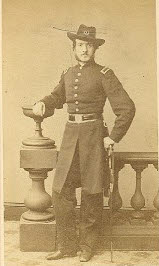
JOST, FREDERICK (1837-1874). Second lieutenant, 5th Regiment, New York State National Guard, Company D. Jost, a native of Prussia, enlisted at New York City on June 19, 1862. He was commissioned into Company D of the 5th New York National Guard, also known as the Jefferson Guard, on July 3, 1863, and mustered out at New York City on July 22 of that year. He last resided in Jersey City, New Jersey. His death was caused by phthisis pulmonalis. Section 32, lot 12255.
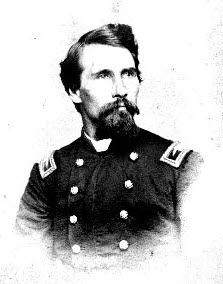
JOURDAN, JAMES (1832-1910). Major general and brigadier general by brevet; colonel, 158th New York; lieutenant colonel, 56th New York Infantry; major, 84th New York (14th Brooklyn) Infantry. Jourdan was born in New York and was a carpenter and builder by trade. After enlisting as a major on April 18, 1861, at Brooklyn, he was commissioned into the 14th Brooklyn’s Field and Staff on May 23. Colonel Andrew Porter, his commanding officer, wrote from Arlington, Virginia, on July 25, 1861, “The officers of the Fourteenth, especially Maj. James Jourdan, were distinguished by their display of spirit and efficiency throughout the action…” He was discharged for promotion to lieutenant colonel when he was transferred and commissioned into the 56th New York’s Field and Staff on January 2, 1862. He was discharged on August 5, 1862, and later commanded the 158th New York. In his field report to Major R. S. Davis in Beaufort, North Carolina, on February 5, 1864, Jourdan noted that his communications with New Berne, North Carolina, were severed but he had reinforcements to hold his position and would do all he could. He wrote, “Have no field artillery; the enemy has six pieces; will put 24-pounder howitzer on railroad car…”
On October 28, 1864, he was brevetted brigadier general of United States Volunteers for his actions in the attack on the enemy’s works at Fort Harrison, Virginia, and on March 13, 1865, was brevetted major general “for his gallant and meritorious services during the War.” He was chosen colonel of the 13th Brooklyn Regiment in 1866, made brigadier general of the Fifth Brigade in 1875, and was brevetted major general in 1878.
Always active in civic affairs, he was one of the “Three Graces” of Brooklyn, who, along with Benjamin F. Tracey (see) and Silas Dutcher, ran the Brooklyn Republican organization. During the Grant Administration, he worked for the Internal Revenue Service, and led raids against moonshiners in Brooklyn’s Fifth Ward. He served as Brooklyn’s police commissioner and president of its Board of Health, was first vice president of the 14th’s Veteran’ Association in 1817, and was president of the Brooklyn Union Gas Company. Jourdan was a Brooklyn resident at the time of his death, which was caused by apoplexy. Section 142, lot 24090.
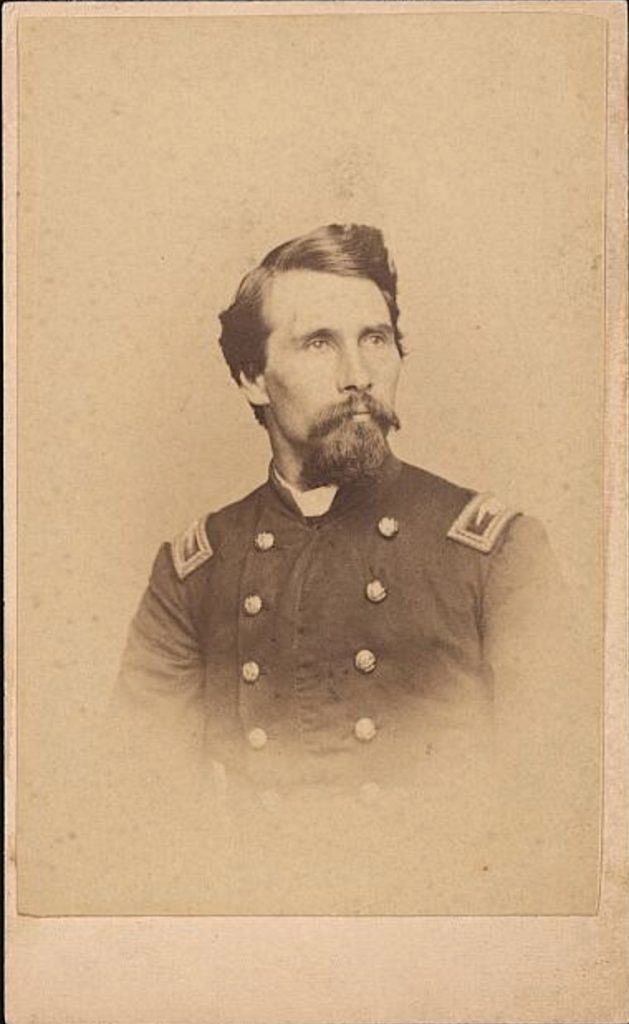
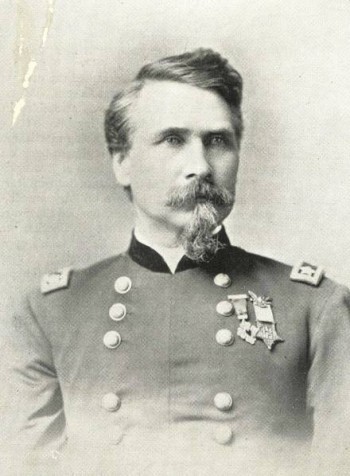

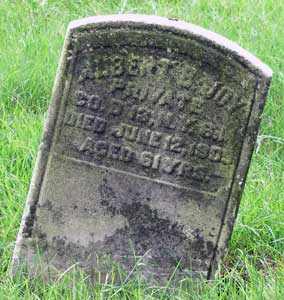
JOY, ALBERT B. (1843-1905). Private, 13th Regiment, New York State National Guard, Company D. Once he enlisted at Brooklyn as a private on May 28, 1862, he mustered immediately into the 13th National Guard, and mustered out after three months on September 12 at Brooklyn. It is likely that he was the brother of Charles Joy (see). As per his obituary in the Daily Standard Union, he was the chief doorkeeper at the Consolidated Stock Exchange, where he had been employed for twenty-five years. In addition, he was a Freemason. He last lived at 678 Fulton Street in Brooklyn. Section 93, lot 10956.
JOY, CHARLES H. (1834-1905). Captain, 23rd Regiment, New York State National Guard, Company H. Joy was commissioned into the 23rd National Guard on June 18, 1863, and mustered out after 30 days on July 22 at Brooklyn. It is likely that he was the brother of Albert Joy (see). He last lived at 14 Putnam Avenue in Brooklyn. His death was attributed to cirrhosis. Section 93, lot 10956, grave 4.

JOYCE, CHARLES A. (1844-1874). Second lieutenant, 88th New York Infantry, Companies C, A, and D; private, 1st Regiment, Veteran Reserve Corps, Company H. A native of New York, Joyce enlisted there as a private on November 5, 1861, and mustered that day into Company C of the 88th New York. On June 12, 1863, he was transferred to Company A, and was wounded at Gettysburg, Pennsylvania, on July 2. He was transferred into the 1st Regiment Veteran Reserve Corps on February 1, 1864, but returned to Company A of the 88th on August 2. The next month, he was promoted to sergeant on September 1, and mustered out on October 6, 1864, at Petersburg, Virginia. Subsequently, he returned to service mustering into Company D of the 88th with a promotion to first sergeant on April 1, 1865, and was promoted to second lieutenant on May 31, 1865, but was not mustered. On June 30, 1865, he mustered out at Alexandria, Virginia. Joyce last lived at 272 Ryerson Street in Brooklyn. His death was caused by phthisis pulmonalis. Section 93, lot 5804.

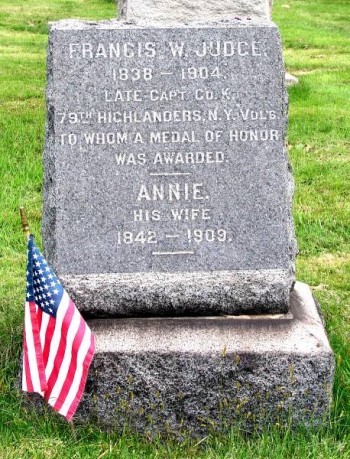
JUDGE, FRANCIS W. (1838-1904). Medal of Honor recipient; major by brevet; captain, 79th New York Infantry, Companies K and A. Of English birth, he was a porter when he entered service. Judge enlisted at New York City as a private on May 13, 1861, and mustered into the 79th New York. As per his muster roll, he was 5’8″ tall, weighed 140 pounds, had brown hair and eyes, and a dark complexion. He was promoted to first sergeant on April 4, 1863.
Judge was awarded the Medal of Honor for his valiant effort at Fort Sanders in Knoxville, Tennessee, on November 29, 1863, when he leaped from his position of safety under concentrated fire, sprang upon the parapet and seized the Confederate flag planted by the color bearer of the 51st Georgia Infantry (C.S.A.) and returned with it to the fort. He mustered out on May 31, 1864, at New York. Promoted to first lieutenant, but not mustered, on September 30, 1864, he re-enlisted on February 2, 1865, returned to Company A of the 79th on February 21, was promoted to captain on March 17, 1865, and mustered out on July 14, 1865, at Alexandria, Virginia. Judge was brevetted to major in January 1866, “for gallantry in the field and meritorious conduct in camp.”
Employed as a clerk after the Civil War, he lived in Manhattan until 1891 when he moved to Brooklyn. In 1904, his application for an invalid pension was granted, certificate 1,089,603. At the time of his death from cancer, he lived at 479 Herkimer Street in Brooklyn. His widow and second wife, Annie Judge, applied for and received a pension after his death in 1904, certificate 592,960. Section 207, lot 31870.
JUNK, ROBERT (1836-1874). Private, 162nd New York Infantry, Company G. Of Irish origin, Junk enlisted as a private at New York City on September 15, 1862, and mustered into the 162nd New York on October 18. He was wounded at Cane River Crossing, Louisiana, on April 23, 1864, and deserted on September 25, 1864, at New York City. He last lived at 405 West 40th Street in Manhattan; his death was caused by phthisis. Section 126, lot 5047, grave 833.
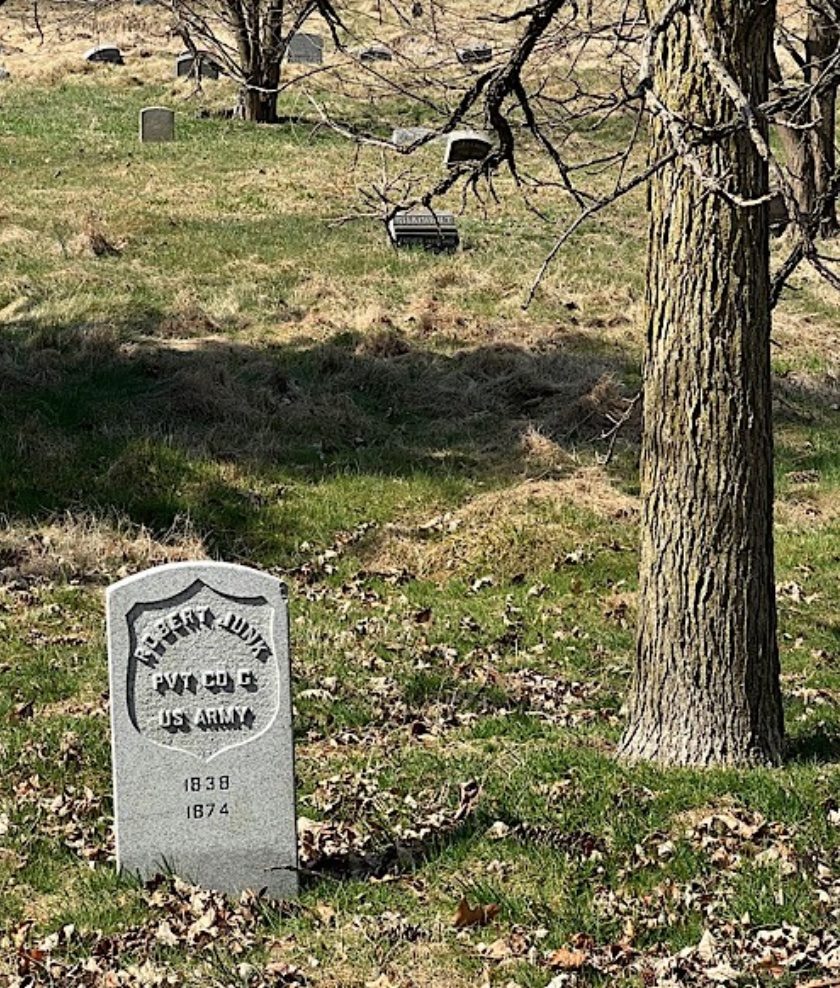
JURGENS, HENRY (1842-1914). Private, 8th New York Infantry, Company G. A native of Germany, Jurgens enlisted at New York City on April 23, 1861, immediately mustered into the 8th New York, and mustered out on April 23, 1863, at Brooks’ Station, Virginia. In 1890, he applied for and received an invalid pension, certificate 771,014. As per his obituary in the Brooklyn Standard Union, he worked for Frederick H. Levey Company, manufacturers of printers’ inks. His last address was 255 43rd Street in Brooklyn. He died of endocarditis. Mary Jurgens applied for and received a widow’s pension in 1914, certificate 490,123. Section 16, lot 14888, grave 245.
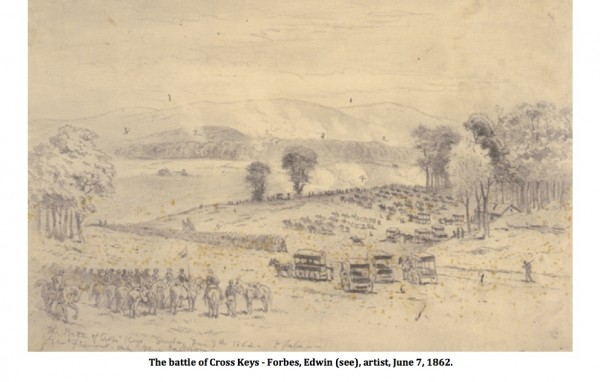
KAHLMEYER (or CAHLMEYER), WILLIAM F. H. (1822-1905). First sergeant, 8th New York Infantry, Company E. Born in Breslau, Germany, and a jeweler by trade, he came to America at age 27. Kahlmeyer enlisted as a private on April 23, 1861, at New York City, and mustered into the 8th New York. As per his muster roll, he was 5′ 7″ with gray eyes, light complexion and light hair. He was promoted to first sergeant on August 5, 1861. He was shot in the right arm below the shoulder when ordered to right about face at the Battle of Cross Keys, Virginia, on June 8, 1862. His humerus was shattered just below the shoulder and 19 bone fragments were removed. He also suffered nerve and muscle damage leaving his arm permanently bent with very limited mobility in his shoulder. After he was discharged for disability on January 28, 1863, at the United States Army Hospital in Philadelphia, Pennsylvania, Kahlmeyer was incapacitated for three years. He applied for and received an invalid’s pension in 1863, certificate 15,840. In 1903, he applied for an increased pension on grounds of total disability. His obituary in the Brooklyn Standard Union, which confirmed his Civil War service and battle injury, noted that the cause of his death was gangrene. He last resided at 136 12th Street in Brooklyn. In 1905, his widow, Catharine Kahlmeyer, received a pension, certificate 594,659. Section 195, lot 30306.
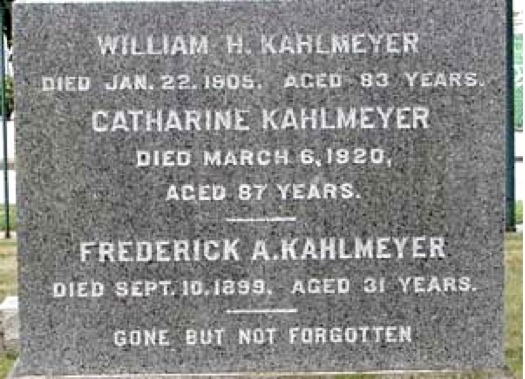

KALBFLEISCH, MARTIN (1804-1873). Mayor of Brooklyn and Congressman. Born in Flushing, Holland, he studied chemistry there, then went to sea with an American captain at the age of 18. Their mission was to engage in trade with Sumatra but the vessel was forced to return to Europe because a cholera epidemic had struck. For the next four years, Kalbfleisch and the American engaged in business in France. He immigrated to the United States and settled in New York City in 1826. At first a manufacturer of paints in Harlem, he established a chemical factory in 1844 that bore his name in Greenpoint, Brooklyn, earning him a substantial fortune. He was also involved in politics, serving as health warden in 1832, school trustee in 1836, and supervisor of Bushwick from 1852-1854. Although he did not win the mayoralty of Brooklyn in 1854, he was an alderman of the Eighteenth Ward in Brooklyn from 1854-1861 and then was elected Brooklyn’s mayor from 1862-1864.
During the Civil War, Kalbfleisch’s fiscally conservative politics earned him much criticism. Against public opinion, he refused to raise large sums for regiments or provide relief to soldiers’ families. He also opposed President Abraham Lincoln’s policies in favor of emancipation and conscription. Although not considered an extreme “Peace Democrat,” he was denied his party’s nomination for re-election and lost as a third-party candidate. However, he served in the 38th Congress from March 4, 1863, through March 3, 1865, as a Democrat, and continued to oppose the President’s policies for emancipation, African-American service in the military, and the establishment of the Freedmen’s Bureau. Subsequently, he was a delegate to the Union National Convention at Philadelphia in 1866. Despite being denied election to the mayoralty in 1865, Kalbfleisch ran again and was elected mayor of Brooklyn, serving 1867-1871, then retired from political life after losing as an independent in a re-election bid. According to his obituary in The New York Times, he was known as the “Honest Old Dutchman,” and was president of the Prospect Park Trotting Association and the Oceanus Club. In addition, he was associated with several financial institutions and left a personal estate worth $2,000,000. Section 68, lot 3053.
KALTENBACH, ERNEST (or ERNST) (1828-1907). Quartermaster sergeant, 30th New York Light Artillery; 29th New York Light Artillery. Born in Baden, Germany, Kaltenbach’s obituary notes that he was exiled from that country for his role there in the 1848 Revolution. He enlisted at New York City on an unknown date and mustered into the 30th New York Light Artillery on August 8, 1861. At some point, he transferred into the 29th New York Light Artillery from which he was discharged. In 1890, his application for an invalid pension was granted, certificate 706,087. Kaltenbach was employed as a lithographer and was a member of the Koltes Post #32 of the G.A.R. He last lived at 2404 Foster Avenue in Brooklyn. His death was attributed to senility. Section P, lot 31693, grave 5.
KANE, PIERRE C. (1831-1870). Colonel by brevet; lieutenant colonel, 47th New York Infantry, Company H; 10th Regiment, Veteran Reserve Corps. A native New Yorker, he enlisted there as a captain on an unknown date, and was commissioned into Company H of the 47th New York. He rose to major on about January 15, 1862, transferred to the Field and Staff that day, and became the lieutenant colonel on August 5 of that year. On November 15, 1862, he was discharged for disability. Kane rejoined the service as a lieutenant colonel of the 10th Regiment, Veteran Reserve Corps, but resigned on July 11, 1864. He was brevetted colonel “for gallant and meritorious services during the War,” dating from March 13, 1865. His last residence was in Douglaston, Queens. His widow, Edith Kane, applied for a pension in 1890, application 471,264, but it was not certified. A minor was granted a pension in 1891, certificate 368,616. Section 178, lot 14094.
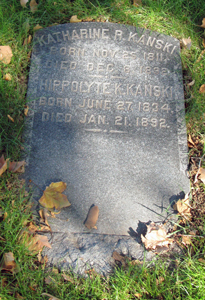
KANSKI, (or CANSKI, KANSKE), HIPPOLYTE (or HIPPOLITE, HIPOLYTE, HEPPOLICE, HIPPOTLE, HYPOLYTE), CASPIAN (or E., K.) (1834-1892). Private, 22nd Regiment, New York State National Guard, Company D. Kanski was born in Krakow, Poland. As per the 1855 New York State census, which records his name as “Heppolice Canski,” he lived in New York City with his parents, older brother and six younger siblings. The New York Daily Tribune announced his marriage on June 20, 1855, to Martha Hall of New York City at the home of the bride’s mother. Kanski’s name is recorded in the Episcopal Church Records for New York City with a date of October 20, 1856; perhaps that was related to his son’s birth. He was still a New York City resident at the time of the 1860 census and was living with his wife, Martha, and three-year-old son who bore his name. That census notes that he was a clerk and that his home was valued at $4,000.
On May 28, 1862, Kanski enlisted as a private at New York City and mustered immediately into Company E of the 22nd Regiment from which he mustered out after three months at New York City on September 5. His Draft Registration Record of 1863 shows that he lived in Manhattan and worked as a clerk. He had been a clerk for the North American Fire Insurance Company for many years as per his testimony in Probate Court in 1863 verifying the signature of a stockholder in that company.
As per the 1868 New York City Directory, Kanski lived on East 126th Street near Third Avenue and worked as a clerk. According to the 1870 census, he lived in Manhattan with Martha Kanski, who was identified as his “inferred spouse,” and worked as a clerk. The 1890 Veterans Census confirms his Civil War service, notes his service in the 22nd Regiment with a discharge date of 1863, possibly indicating additional service when that regiment served from June 18 through July 24, 1863. He then lived at 221 East 127th Street and claimed that he “has lost all papers.” The 1894 New York City Directory shows H. C. Kanski employed as a clerk who lived at 165 East 11th Street. He last lived in Manhattan on 3rd Avenue near 124th Street. His death was caused by nephritis. A widower at the time of his death, he was survived by two sons; his fifteen-year-old daughter died in 1879. Section 125, lot 27263, grave 2467.
KARLEN, ALFRED T. (1839-1899). Private, 165th New York Infantry. Born in Sweden, Karlen served in the 165th New York. Details of his service are not specified. In 1893, his application for an invalid pension was granted, certificate 943,764. He joined the G.A.R. on March 1, 1895. As per his obituary in the New York Herald, his comrades in the Lafayette Post #140 of the G.A.R. were invited to attend his funeral; members were requested to wear the Post uniform and white gloves. His widow, Olivia Karlen, applied for and received a pension in 1900, certificate number 553,264. Section 85, lot 3330, grave 9.
KARMANN, LEWIS (1838-1870). Sergeant, 67th New York Infantry, Company A. Born in Germany, Karmann enlisted at Brooklyn as a private on May 29, 1861, and mustered into the 67th a month later on June 20. On May 31, 1862, he was wounded in action at the Battle of Seven Pines, Virginia. He rose through the ranks and became a corporal on September 28, 1863, and then became a sergeant on May 7, 1864. He mustered out of service at Brooklyn on July 4, 1864, due to wounds. His last residence was at 281 Adams Street in Brooklyn. He died of sunstroke. Section 133, lot 17931, grave 38.
KARR, THOMAS (1844-1889). Private, 133rd New York Infantry, Company E. After Karr enlisted at New York City as a private on August 19, 1862, he mustered into the 133rd New York on September 24, and was discharged for disability on October 1, 1862, at Staten Island. He last lived at 422 East 124th Street in Manhattan. Karr succumbed to nephritis. Section 181, lot 14049.
KARSEBOOM, HARMANUS L. (1835-1913). Private, 2nd New Jersey Infantry, Company K. Karseboom was born in Providence, Rhode Island. He married his first wife, Charity Blue, in Newark, New Jersey, on March 4, 1856; the couple had two children prior to their divorce. After enlisting as a private on May 30, 1861, Karseboom mustered immediately into Company K of the 2nd New Jersey Infantry. He mustered out at Newark, New Jersey, on June 21, 1864. As per an online biography, Harmanus’s brother, William, who also fought in the Civil War, lost his hand in battle.
On June 6, 1867, he married Mary Pearson; they had three children. In 1895, his application for an invalid pension was approved, certificate 907,789. He last resided at 481 18th Street in Brooklyn. Shortly after his death in 1913, Mary Karseboom applied for and received a widow’s pension, certificate 768,125. Section 16, lot 14888, grave 44.
KASTNER, RICHARD (1846-1872). Private, 69th New York Infantry, Company G; 19th Infantry, Veteran Reserve Corps, Company G. Kastner, who was born in Germany, enlisted at New York City as a private on January 19, 1864, and mustered into the 69th New York that day. He was wounded in action on June 3, 1864, at the Battle of Cold Harbor, Virginia. He transferred into the 19th Veteran Reserve Corps on January 24, 1865, from which he mustered out on August 4, 1865, at Buffalo, New York. On August 14, 1865, he applied for an invalid pension that was granted under certificate 59,696. In civilian life, he was employed as a tailor. His last residence was 78 Hudson Street in Manhattan. Consumption was the cause of his death. Section B, lot 9895, grave 819.
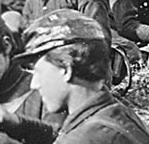
KATEN, WASHINGTON (1844-1925). Private, 170th New York Infantry, Company B. Katen enlisted at Brooklyn as a private on August 22, 1862, and mustered into the 170th New York on October 7. After he was wounded in action at the Battle of Petersburg, Virginia, on June 16, 1864, he returned to his regiment and was discharged from service on June 29, 1865. He also went by the name George W. Keating. His application for an invalid pension made in 1886 was granted, certificate 355,047. His last residence was 143 East 165th Street in Manhattan. Myocarditis is listed as the cause of his death. Section 73, lot 6028, grave 1.

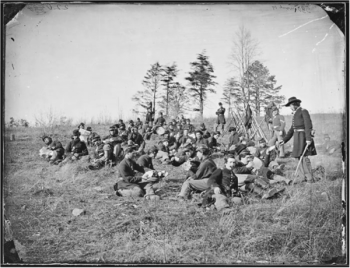
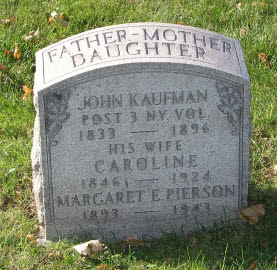
KAUFMAN (or KAUFFMAN), JOHN (1833-1896). Private, 173rd New York Infantry, Company C. A native of Germany, Kaufman enlisted as a private at Brooklyn on September 24, 1862, and mustered into the 173rd on October 30. Taken as a prisoner of war on April 9, 1864, at Pleasant Hill, Louisiana, he was paroled on May 27, 1865, and discharged on July 28 of that year at New York City. He last lived on Baltic Street in Brooklyn. He died of apoplexy. Section 17, lot 17245, grave 1402.
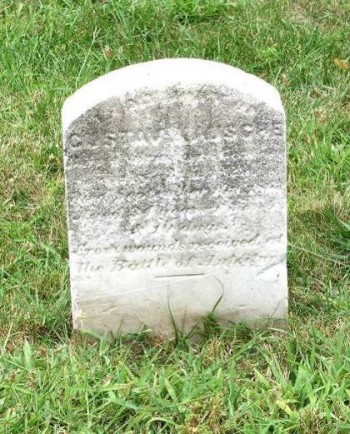
KAUSCHE (or KAUSEPE), GUSTAV (or GUSTAVUS) (1829-1863). Private, 20th New York Infantry, Company D. Originally from Germany, Kausche enlisted on May 3, 1861, at New York City and mustered into the 20th New York three days later. He was severely wounded in the right leg at the Battle of Antietam, Maryland, on September 17, 1862. On April 30, 1863, he was listed as absent, sick, at the hospital in Frederick, Maryland. He was discharged due to his wound on August 13, 1863, at Frederick. According to cemetery records, he died on September 10, 1863, of “disease of the spine.” Section 116, lot 4196, grave 659.
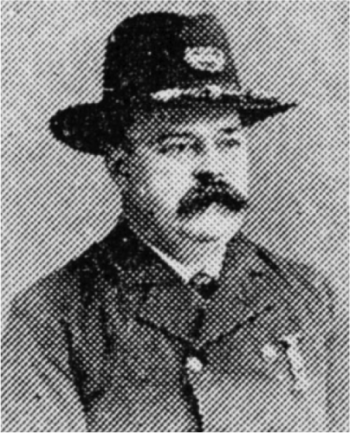
KAY, JOSEPH WILLIAM (1844-1928). Private, 22nd Regiment, New York State National Guard, Company F; 10th New York Infantry, Companies A and B. Kay, who was born in New York State, first served in the 22nd New York State National Guard for three months in 1862. After re-enlisting on September 22, 1862, at New York City, he mustered into Company A of the 10th New York the next day. On April 26, 1863, he was transferred intra-regimentally to Company B. He was wounded in Cold Harbor, Virginia, on June 3, 1864, and discharged at Annapolis, Maryland, on July 1, 1865.
In 1879, he established Jos. W. Kay, a well-known footwear business at 83 Fifth Avenue in Manhattan which sold fine boots and shoes for the entire family. The business was known for its five dollar hand-sewn calf shoes for gentlemen, the large and superior stock that was available, and the attractive layout of merchandise. The establishment moved to 496 Fifth Avenue in 1884. Remaining active in military affairs, Kay was a member of the Winchester Post #197 of the G.A.R., held a leadership position in the G.A.R. as a Department of New York Commander in 1899, and was business manager of the Grand Army Publishing Company at 98 Maiden Lane in Manhattan which published the Grand Army Review, a monthly devoted to veterans’ affairs and an advocate for veterans’ rights in civil service employment. In addition, he was a Freemason and member of the Knights Templar. His last residence was on Park Place in Brooklyn. Kay’s death was caused by cardiac arrest. Section 197, lot 28720.
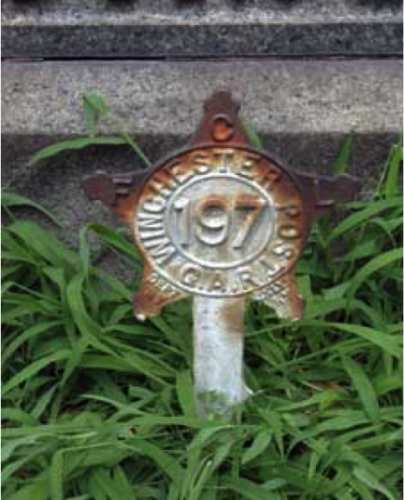
KAY, PETER SCOTT (1828-1903). Private, 51st New York Infantry, Company G; 83rd Veteran Reserve Corps; 10th Veteran Reserve Corps, Company E. A marble-cutter by trade (according to family lore, he worked at Green-Wood Cemetery both before and after the Civil War), Kay enlisted on September 10, 1861, and mustered into the 51st two days later. He was transferred to the 83rd Veteran Reserve Corps on November 18, 1863, and mustered out on September 12, 1864. During his service, he was hospitalized twice for illness, once for a kidney infection, and also for chronic diarrhea, returning to duty after each confinement. He enlisted again on October 7, 1864, and served with the 10th Veteran Reserve Corps, Company E, until he was discharged on December 22, 1865. In 1890, he applied for and was granted an invalid pension, certificate 793,455. He last resided on 67th Street and 14th Avenue in Brooklyn. He succumbed to Hodgkin’s disease. In 1903, his widow, Rachel Kay, applied for and received a pension, certificate 568,158. Section 200, lot 26505, grave 3.
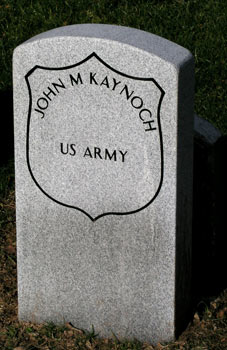
KAYNOCK (or KYNOCK), JOHN McKENZIE (1828-1870). Unknown soldier history. Kaynock, who was born in Scotland, is buried in Green-Wood’s Soldiers’ Lot, an area set aside for Civil War veterans. Although his soldier history is unknown, it is most likely that he served his adopted country. It is possible that he is the John McKenzie who enlisted as a private at New York City on September 6, 1861, mustered into the 43rd New York’s Company H that day, and transferred to Company E on July 8, 1862. That soldier re-enlisted on December 24, 1864, and subsequently transferred into the United States Navy on April 14, 1864. He last lived in New York City and he died there of pneumonia. Section 115, lot 13536 (Soldiers’ Lot), grave 114.
KEANE, HUGH VICTOR (1839-1871). Sergeant, 10th New York Infantry, Companies A and B. Keane enlisted at New York City as a private on August 27, 1862, and mustered into Company A of the 10th New York two days later. On April 26, 1863, he was transferred to Company B and subsequently was promoted to commissary sergeant upon his transfer to Field and Staff on May 1. On August 26, 1863, he transferred back to Company B with the rank of sergeant. On April 28, 1864, he was again made commissary sergeant. He mustered out at Munson’s Hill, Virginia, on June 30, 1865. His last residence was 364 Atlantic Avenue, Brooklyn. His death was caused by heart disease. Section L, lot 20415.
KEARNEY, FRANK (1841-1881). Private, 22nd Regiment, New York State National Guard, Company B. After enlisting at New York City, his birthplace, and mustering into the 22nd National Guard for three months on May 28, 1862, he mustered out on September 5 at New York City. When his regiment was reactivated in 1863, he served with his company for 30 days. He last resided at 60 Dey Street in Manhattan. Convulsions is listed as the cause of his death. Section 167, lot 16010.
KEARSING, EDWARD (or EDWIN) F. (or H.) (1836-1916). Private, 84th New York (14th Brooklyn) Infantry, Company K. A dentist, Kearsing was 5′ 8″ tall with blue eyes, brown hair and a fair complexion. After enlisting at Brooklyn on August 29, 1862, he mustered into the 14th the next day, and was discharged for disability on December 13, 1862, at Washington, D.C. Upon his discharge, he received $28.86: $18.63 in back pay for a month and 13 days (at $13 per month), $4.73 for transportation from his place of discharge to New York City (220 miles at 20 miles per day, equal to pay for 11 days), and $5.50 subsistence (at 50 cents per day for rations for the 11 days). Kearsing was a member of the G.A.R.’s Ulysses S. Grant Post #327. In 1902, he applied for and was granted an invalid pension, certificate 1,040,420. His last residence was at 115 Minna Street in Brooklyn. He died of myocarditis. Section 152, lot 18921.
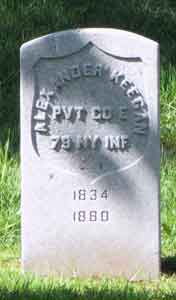
KEEGAN, ALEXANDER (1834-1880). Private, 79th New York Infantry, Company E. A native of Ireland, Keegan enlisted at New York City as a private on May 13, 1861, and mustered into the 79th on May 28. He was discharged from military service on July 30, 1861. His death was attributed to bronchitis. Section 2, lot 5499, grave 173.
KEEGAN, WILLIAM (1839-1875). Private, 69th Regiment, New York State National Guard; 182nd New York Infantry, Company G. Keegan, who enlisted as a private at New York City on October 1, 1862, originally mustered into the 69th National Guard. He then joined Company G of the 182nd Infantry on November 17. The 182nd was first sent to Washington, D.C., and then fought in Virginia. On October 17, 1864, he was wounded and captured at Boydton Road, Virginia, outside of Petersburg, and returned to his regiment from Camp Parole in Annapolis, Maryland, on April 3, 1865. Keegan was discharged on June 26, 1865, at Munson’s Hill, Virginia, as per General Order #77. He last lived at 149 17th Street in Brooklyn. His death was attributed to heart disease. Section 114, lot 8999, grave 963.
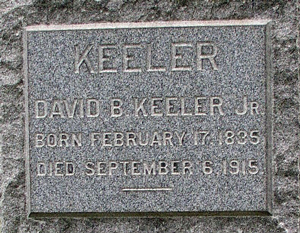
KEELER, JR., DAVID BURR (1835-1915). Adjutant, 8th Regiment, New York State Militia. Keeler was born on Shelter Island in Suffolk County, New York. As per Base Ball Founders, edited by Peter Morris et al., Keeler was club treasurer of the Knickerbockers, one of the first organized baseball teams, in 1860; the club first played in 1842 and was formally organized in 1845. In 1860, at one of the monthly meetings of the Knicks, as they were familiarly called, Keeler announced that several team members did not pay their dues, creating a deficit in the club’s treasury. Two members then stood up and stated that they had not been notified to pay dues; a motion was passed fining Keeler two dollars for “neglect of duty for failing to diligently collect the baseball club’s dues.” In addition to his interest in baseball, he was a volunteer fireman before the Civil War.
Keeler enlisted as an adjutant on April 23, 1861, at New York City, was commissioned into the Field and Staff of the 8th Regiment two days later, and mustered out on August 2 of that year at New York City. On July 21, 1861, the 8th Regiment was at Arlington, Virginia, where they engaged in skirmishes with the enemy, alongside the 14th Regiment and then coming to the aid of the 27th Regiment before the men retreated. He returned to the 8th Regiment, then called the National Guard, on May 29, 1862, and resigned shortly thereafter on July 4. During his service, he was an adjutant on the staff of General George B. Buchanan in the Department of Northeastern Virginia.
After the Civil War, Keeler was a successful realtor, playing a major role in the development of Sea Bright, New Jersey, where Albert Goodwill Spalding, an executive in the early years of baseball and founder of a sporting goods company, later lived. His obituary in The New York Times, which confirms his Civil War service, notes that he also played a role in real estate development in the Rumson Road area of New Jersey. In 1883, Keeler financed the construction of Blithewald, a grand mansion in Rumson known later as “the Gatsby house,” foreseeing the area as the potential site for country estates and summer residences. He was also instrumental in building a bridge between Rumson and Sea Bright. His office was at 10 Wall Street in Manhattan. Although Green-Wood records indicate that he died at the Home for Incurables in the Bronx, his obituary notes that he died at his home at 230 West 97th Street in Manhattan; he was survived by two daughters and a son. In March 2019, a letter signed by Keeler related to an 1892 real estate matter involving John S. Applegate, a prominent New Jersey state senator, railroad financier and president of the Monmouth County Historical Society, sold on eBay for $43.00; another letter from March 1893 is pictured below. Section 21, lot 4699.
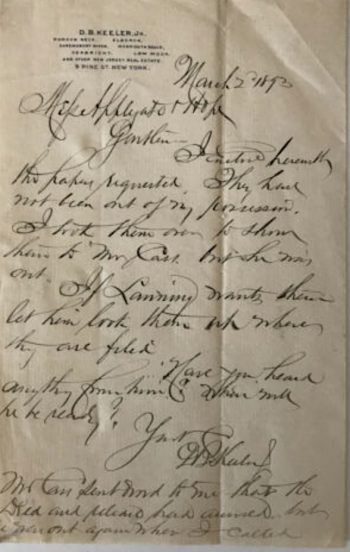
KEELER, JOHN S. (1842-1916). Private, 176th New York Infantry, Company G. After he enlisted as a private at New York City on October 30, 1862, he mustered into the 176th New York on December 18, was taken as a prisoner of war on June 23, 1863, at Brashear City, Louisiana, returned two months later on August 17 at an unstated place, and mustered out on November 16, 1863, at New York City. Section ?, lot ?.
KEELER, ROBERT B. (1841-1899). First lieutenant, 15th New York Heavy Artillery, Companies M and G. Born in Newburgh, New York, Keeler enlisted as a second lieutenant on February 3, 1864, at Fort Lyon, Virginia, and was commissioned into the 15th Heavy Artillery that same day. He was wounded on July 27, 1864, and was promoted to first lieutenant on September 17, 1864, effective upon his transfer to Company G on that date. On August 22, 1865, he mustered out at Washington, D.C. Active in military affairs, he mustered into the George C. Strong Post #534 of the G.A.R. on January 16, 1885. In 1891, his application for an invalid pension was granted, certificate 208,409. He last lived in Newburgh. He succumbed to heart disease. In 1906, Elizabeth Keeler applied for and received a widow’s pension, certificate 645,125. Section 195, lot 30185, grave 2.
KEENE, LAURA (1826-1873). Actress at Ford’s Theater at President Abraham Lincoln’s assassination. A native of Winchester, England, most sources say her birth name was Mary Frances Moss. In 1844, she married a British Army officer, Henry (or John) Wellington Taylor and had two daughters. She was described as puffy-faced and heavy-featured with luxurious auburn hair. Her husband, who had opened a tavern, was arrested in 1850, and sent to Australia as a prisoner. Supposedly, Keene went to Australia to seek a divorce, could not find him, and returned to England impoverished. Following in the footsteps of her aunt, the British actress Elizabeth Yates, she took on the professional name “Laura Keene” and left her two young daughters with her mother to start anew.
Keene came to the United States in 1852, found success as an actress and in 1855, became a theatrical manager, a first for a woman. Keene enjoyed success touring in California and Australia, where she toured with Edwin Booth, the brother of Lincoln’s assassin, John Wilkes Booth. After Keene returned to New York in 1855, she first managed the old Metropolitan Theater, renaming it the Laura Keene Varieties, and in 1856, opened a theater that bore her name; its first production was the debut of Our American Cousin, a comedy that later attained world-renown and notoriety. When that theater closed, she continued with her acting career. After her first husband died in 1860, she married John Lutz, a fellow theater manager.
Perhaps Keene’s most memorable moment came when she appeared in Our American Cousin in the role of Florence Trenchard, the play she had purchased the rights to and performed in at the Ford Theater from April 3-14, 1865. John T. Ford, the theater owner, promised Keene the profits of the last performance as a farewell gift. Little did she know that her last performance in that show serendipitously was on the night of the Lincoln assassination there. The events that immediately followed the assassination are controversial but in recent years, have gained more credence. According to Keene, who some say invented the story, she was present in the presidential box at Ford’s Theater immediately following the shooting of Abraham Lincoln and she cradled Lincoln’s head in the lap of her gown which became stained with his blood. She then preserved the dress with the blood still embedded in its folds. Apparently, the story of Keene and “the dress” did not have much credibility until an article by Billy J. Harbin, a lecturer of speech at the University of Indiana at Jeffersonville, was published in Education Theatre Journal (Volume 18, March 1966) and quoted in Civil War Blog: A Project of Pa Historian by Norman Gasbarro. That article quoted Seaton Munroe, an attorney from Washington, D.C., who claimed that he saw Keene when he passed the Ford Theater upon hearing word of the assassination. He allegedly said 31 years after the assassination, “…Her hair and dress were in disorder, and not only was her gown soaked with Lincoln’s blood, but her hand, ever her cheeks were her fingers had strayed were bedaubed with the sorry stains…..” That eye-witness account provided the impetus for many to perpetuate Keene’s close association with Lincoln as he lay mortally wounded. Army Surgeon Charles Leale, who came to Lincoln’s aid and noted that the wound was mortal, reported decades later that he assented to Keene’s request to come into the box and hold the President’s head in her lap. However, the story about the blood-stained dress is contradicted by many of the eye-witnesses who were present at the theater or in Lincoln’s box; evidently Keene could not have reached the box without an escort and none of the eye-witnesses were called to testify at the co-conspirators’ trial. Many have concluded that since no contemporaneous witness saw the bloody dress, the truth about it is still elusive. To add more to the mystery, the supposed cuff of the blood-stained dress was donated to the National Museum of American History in Washington, D.C. After Lincoln was carried across the street to the Peterson House, it fell to Laura Keene to attempt to calm an overwrought Mary Todd Lincoln as the president lay dying.
In 1869, the same year that her second husband died, Keene took over the management of the Chestnut Street Theater in Philadelphia, a position she held through 1870, and then journeyed West. Among her last projects were editing the magazine Fine Arts, writing plays, lecturing and acting. Her last performance was on July 4, 1873. A fellow actor, Joseph Jefferson, said of her, “…it was her style and carriage that commanded admiration and it was this quality that won her audience. She had, too, the rare power of varying her manner, assuming the rustic walk of a milkmaid or the dignified grace of a queen.” She last lived in Montclair, New Jersey, where she succumbed to tuberculosis. Section 182, lot 21444.
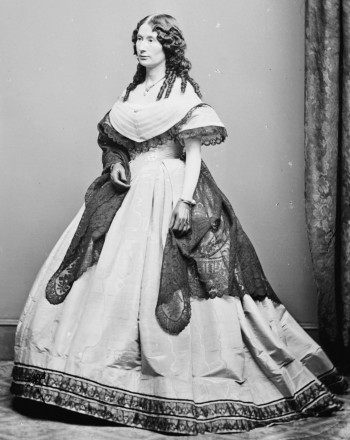
KEENAN, JAMES (1826-1908). Private, 66th New York Infantry, Company H; Veteran Reserve Corps, 22nd Company. Of Irish birth, Keenan enlisted as a private at New York City on September 10, 1861, and mustered into the 66th on November 4. He re-enlisted on December 20, 1863, was wounded on May 12, 1864, at Spotsylvania Court House, Virginia, and was transferred into the Veteran Reserve Corps on March 22, 1865. He mustered out at Washington, D.C., on November 21 of that year. Keenan last resided at the Home for the Aged and Infirm on Ocean Parkway in Brooklyn; her death was attributed to pneumonia. Section 134, lot 29725, grave 380.
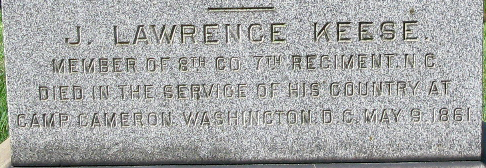
KEESE, JONATHAN LAURENCE (or J. LAWRENCE) (1833-1861). Private, 7th Regiment, New York State Militia, Company H. Keese’s family had historic roots in United States history. The son of a poetry book editor and appraiser of books at the United States Customs House, his paternal great-grandfather was an assistant deputy quartermaster general on George Washington’s staff and a founding member of the Society of Cincinnati. His maternal great grandfather was the Reverend William Linn, the first chaplain of the House of the Representatives under the Constitution in 1787. A salesman in a dry goods store on Frankfort Street in Manhattan, he married the day before his regiment left New York. After mustering into Company H of the 7th Regiment on April 30, 1861, Keese was killed by the accidental discharge of a musket while in camp on May 9, 1861, in Washington, D.C. His was the first death suffered by the 7th. The Regiment posted this bulletin from Camp Cameron, Washington, D.C., on May 9:
At a meeting of the Eighth National Guard, held as above, the following resolutions were unanimously adopted:
Whereas, It has pleased Almighty God, in his allwise providence, to call upon us to mourn, most suddenly, the loss by death of our late fellow-associate and companion in arms J. LAWRENCE KEESE, he having been accidentally shot; therefore, be it.
Resolved, That in the death of Mr. KEESE, who, although but lately connected with us, gave promise by his promptness in responding to the call of his country and diligence in the discharge of his duties of great usefulness in our corps, we feel that we have lost one who had already endeared himself to each and every one of us, and with whom we looked forward to a career of usefulness to our country, and, if spared, a pleasant reunion to the dear ones at home.
Resolved, That while we bow in submission to an Allwise Providence, “who doeth all things well,” we recognize in this dispensation a call to each one of us, “therefore be ye also ready, for in such an hour as ye think not the Son of Man cometh.”
Resolved, That we, the members of the Eighth National Guard, unite in expressing our heartfelt sympathy with the widowed mother and family of our late companion in arms, and assure them that, although unable to be present in person to accompany the remains to their last resting place, our hearts will be with them in this their deep affliction.
Resolved, That a Committee be appointed to make suitable arrangements for conveying the remains to his friends; and that a copy of the above resolutions, suitably engrossed, be sent to the family of the deceased and published in the New-York papers, and that we wear the usual badge of mourning for thirty days.
The following were the escort of the Regiment detailed to accompany Mr. KEESE’s remains homes Sergeant E.C. KITTLE, Privates C.T. JUNG, E. MCJIMSEY, E. BREDT, J. LAMB and H.G. WOLFS.
An article in The New York Times on May 13 revealed that Keese feared he would not return home alive, married his betrothed, and spent half an hour with his bride before joining his regiment that night. His wife, Maria Tucker, saw him for the last time the next day as he marched down Broadway heading for battle. The piece concluded, “The death of young Keese has cast a gloom over a large circle of relations and friends, who were devotedly attached to him.” He was interred at Green-Wood on May 12, 1861. The Brooklyn Daily Eagle reported that members of his company and a regimental drum corps were part of his funeral procession. Section 43, lot 307.
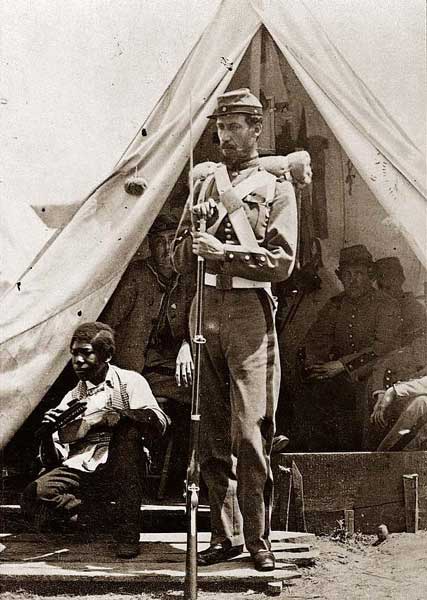
KEESE (or KEYES), MARTIN J. (1837-1909). Private, 11th New York Infantry, Company F. A New York City native, Keese’s life was filled with many different experiences. Prior to the Civil War, he was scheduled to take to sea aboard the Pacific as a substitute, but the assigned crewman showed up at the last minute, the ship sailed without Keese, and was never to be seen or heard from again. He enlisted at New York City as a private on April 20, 1861, mustered into the 11th New York on May 7, and was discharged for disability on July 28, 1861. An article about him in The Wayfarer in New York (1909) by Edward S. Martin noted that he was a fireman with the Matthew T. Brennan Hose Company #60 at the time of his enlistment (where he was active in work-related resolutions) and that he helped put out a fire at the Willard’s Hotel in Washington, D.C., near where his regiment was camped on May 13, 1861. At that conflagration, Keese climbed a lightning rod and was the first on the roof to extinguish the blaze. He was wounded at Bull Run, Virginia. His brother, William Keese, was also wounded at Bull Run and succumbed to his wounds.
Keese was particularly proud of his work as a firefighter, returned to his fire company after his service terminated and was elected company foreman. When Matthew Brennan became sheriff of New York, Keese was his deputy and arrested Boss Tweed on December 17, 1871. According to the 1880 census, he was a hotel keeper; in 1890, the census listed him as janitor at City Hall in Manhattan, a position he held for 30 years beginning in 1881. In The Wayfarer in New York, Keese was interviewed and had this to say about the changes in New York’s skyline: “I was proud of the high buildings when they first began, as all New York was proud of them, but now when I get old enough to have sense, I’m sorry they ever put them up. It was prettier years ago when the little buildings rimmed my square, buildings that were dwarfs compared even to that (pointing to a building outside City Hall). Before they built the skyscrapers, the light and air could get in at the park trees, and that’s why I felt so much friskier then-because the air was better. Before the tall buildings made the square so stuffy I could run up here two or three steps at a time.”
In 1880, Keese applied for an invalid pension, application 347,830, but there is no evidence that it was certified. On March 5, 1896, he was quoted in an article in The New York Times about a proposed memorial hall for Civil War veterans. Keese spoke at the sparsely-attended meeting, said that the proposal should come from the public, not the veterans, and that a simple arch would be a fitting tribute. There were numerous articles in which his name was mentioned in The Times including an article on April 25, 1897, “City Hall Is His Castle,” describing his family life, children and cats encompassing 16 years on the upper floor of the edifice. An article on November 28, 1900, referred to him as the “historian of City Hall” and noted his ease of communicating and his collection of scraps of paper on which anecdotes of his experiences were jotted down including the many functions at the residence and visits from domestic and foreign dignitaries. On May 12, 1901, his name was mentioned in The Times article about a fatal construction accident across from City Hall when a derrick dropped a steel bucket filled with soil during the building of a transit tunnel. Keese witnessed the incident and went to the police station in City Hall notifying the sergeant who in turn called ambulances and sent patrolmen to the scene to disperse the crowd. On September 30, 1904, his name again was in The Times, this time when the scales of justice were “missing” from a statue atop City Hall. After Keese went to the roof to investigate, he discovered that the soldering had worn away.
Keese last resided in New York City at City Hall where he worked. He was a leader and charter member of Noah L. Farnham Post #458 of the G.A.R. and active in New York City’s Volunteer Firemen’s Association. As per his obituary in the New York Herald, he was a member of the Association of Exempt Firemen; its members were invited to attend his funeral with pallbearers asked to wear fatigue caps. His death was due to chronic bronchitis. His remains were moved to their present location in October 1909. Marty K, a facilities management company in Mercer, Washington, was named in his honor and hopes to maintain his ideals of service and character in today’s business environment. Section 6, lot 33121, grave 1.
KEESE, MORITZ (1833-1882). Private, 8th Battalion D.C. Infantry, Company A. A native of Hanover, Germany, he immigrated to the United States on June 1, 1858. The 1860 census reports that he was living in Washington, D.C., and working as a dyer; he owned $200 of personal property. During the Civil War, he enlisted as a private at Washington, D.C., on April 16, 1861, and mustered that day into Company A of the 8th Battalion D.C. Infantry. There are no further details about his service.
Keese became a naturalized citizen on October 17, 1866; he lived at 49 Essex Street in Manhattan at that time. According to the census of 1880, he was a cigar packer who lived with his wife in Jersey City, New Jersey; he is listed as a packer in the 1881 Jersey City Directory. In 1881, he applied for an invalid pension, application 425,677, but he apparently died before it was certified. Keese last lived on West Newark Avenue in New Providence, New Jersey. He died from phthisis. A contract dated January 21, 1883, indicates that a government headstone was provided for him at Green-Wood. In 1884, Clara Keese, who is interred with him, applied for and received a widow’s pension, certificate 309,187. Section 121, lot 12418.
KEESE, WILLIAM LINN (1834-1904). Third corporal, 8th Regiment, New York State National Guard, Company K. Keese, who was born in Brooklyn, enlisted there as a private in 1862, mustered into the 8th Regiment for its activation of three months and was promoted to third corporal before he was discharged. As per his obituary in the New York Herald, he was a founding member of the Military Order Foreign Wars, United States National Commandery; members were requested to attend the funeral wearing the organization’s insignia draped with crepe. In addition, he was the treasurer of the State Society and a member of its Standing Committee. His last residence was 41 Ocean Avenue in Brooklyn. He died of a cerebral hemorrhage. Section 51, lot 12790.
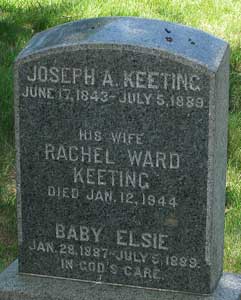
KEETING, JOSEPH A. (1843-1889). Corporal, 13th Massachusetts Infantry, Company C. A farmer who was born in Lowell, Massachusetts, Keeting resided in Natick, Massachusetts, when he enlisted on June 29, 1861. He mustered into the 13th Massachusetts on July 16 of that year. He was wounded at Second Bull Run, Virginia, on August 30, 1862, was promoted to corporal on May 1, 1864, and carried the national colors from May 8-August 1, 1864, the date he mustered out at Boston, Massachusetts.
He died in Little Silver, New Jersey, along with his mother-in-law and 29-month-old old daughter when their horse-drawn carriage was struck by a locomotive of the Long Branch Railroad. According to an article in The New York Times, an inquest into the accident determined that the railroad engineer did not see that the horse stopped on the tracks until it was too late. The railroad company was censured for not having a flagman at the crossing. He last lived at 813 Lexington Avenue in Manhattan. In 1890, his widow, Rachel Keeting, who is interred with him, applied for and received a pension, certificate 318,377. Section H, lot 20272.
KEIL, GEORGE W. (1846-1899). Private, 22nd Regiment, New York State Militia, Companies K and G. Keil first served as a private in the 22nd Regiment’s Company K for 30 days in 1861. He returned to the 22nd Regiment, now part of the New York State National Guard, for 30 days in 1863 and was in Company G. His Civil War service was confirmed by the Veterans Schedule in 1890. He last lived at 112 East 85th Street in Manhattan. Records list his death was caused by asphyxia. Section 15, lot 9055, grave 3.

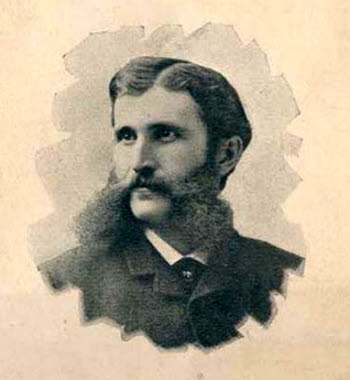
KEILEY, WILLIAM SHIPPIN (1845-1925). Private, 12th Virginia Light Artillery, Battery B, Confederate States of America. Originally from Petersburg, Virginia, Keiley enlisted at age 15 and first served as a clerk from 1861-1864. He then enlisted as a private on June 15, 1864, and immediately mustered into Battery B of the 12th Virginia Light Artillery, informally known as Martin’s Battery and rose to corporal. On April 8, 1865, he fought at the Battle of Appomattox Court House, Virginia, manning the number one gun. He was taken prisoner of war and sent to Libby Prison, (which, after housing Union prisoners for years, had been switched to hold Confederates), from which he was paroled on April 15, 1865. On May 15, 1865 he pledged the Oath of Allegiance to the United States.
After the War, Keiley moved to New York City where he became a lawyer, was named the clerk of the Court of Common Pleas, and where among his many cases, he witnessed the divorce proceedings of the famed writer Upton Sinclair. An interesting anecdote appeared in a New York paper noting that there was a fraternal feeling between North and South in the Court of Common Pleas where a judge, Roger Pryor, and Keiley were both Confederate War veterans. He also worked as a Latin professor at Seton Hall University in New Jersey and wrote The Law and Practice of Insolvent Assignment. Also, he served as the post commander of the Confederate Camp of New York and wrote a book about the final days of the Civil War, A Battery’s Last Shot. His father-in-law was James A. Boyle (see). One of Keiley’s obituaries in The New York Times read in part, “Confederate Veterans, attention! …Comrades and friends are requested to join in paying the last sad rites by attendance at the funeral….” His last residence was 527 West 113th Street in Manhattan; his death was attributed to injuries from being struck by a streetcar. Section 183, lot 20394, grave 2.
KEIM, PHILLIP (or PHILIP) (1834-1892). Private, 68th New York Infantry, Companies E and G. Of German origin, Keim enlisted at New York City as a private on August 8, 1861, and mustered into Company E of the 68th New York six days later. His muster roll indicates that he was transferred into Company G in March or April 1862. Keim was wounded in action at the Battle of Second Bull Run, Virginia, on August 28, 1862, hospitalized at Philadelphia, Pennsylvania, and returned to his regiment in December 1862. According to his muster roll, he was hospitalized in August 1863, and dropped from the rolls on June 30, 1864, as per Special Order #45, Army of the Cumberland. His last residence was at 533 Warren Street in Brooklyn. He died in 1892 of uraemia. Section 135, lot 27263, grave 2127.
KEIPER, CHARLES (1840-1903). Private, 8th New York Infantry, Company A. Of German birth, Keiper enlisted at New York City as a private on October 1, 1861, and mustered into the 8th New York Infantry the same day. He was discharged for disability on April 1, 1862, at Hunter’s Chapel, Virginia. He last resided at 4 East 89th Street, New York City. He died from cancer. Section 15, lot 17263, grave 140.
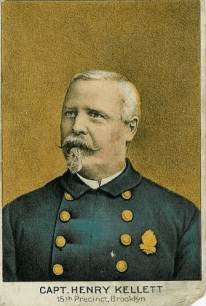
KELLETT, HENRY (1838-1898). First lieutenant, 90th New York Infantry, Companies G and A; private, 13th Regiment, New York State Militia, Company A. Of Irish origin, he served three months with the 13th New York State Militia in 1861. Subsequently, he re-enlisted as a sergeant at Brooklyn, mustered into the 90th New York and was promoted to first sergeant on December 20, 1861. During his military service, he was promoted to sergeant major on June 1, 1862, and transferred to Field and Staff on that date, then promoted to first lieutenant and transferred to Company A on July 29, 1862. He was promoted to first lieutenant on April 13, 1863. Kellett was wounded at Cedar Creek, Virginia, on October 19, 1864, and discharged on December 9, 1864. His obituary noted that he fought in many of the major battles of the Civil War including Fredericksburg, Virginia, and at the siege of Port Hudson, Louisiana.
A policeman after the Civil War, Kellett was appointed in 1867, made sergeant in 1872, and was a captain in 1885 when placed in command of the 15th Precinct. In 1889, he was captain of the 18th Precinct in Brooklyn, and an article in The New York Times announcing his marriage stated that he was one of the biggest men on the force at 6’5″ tall and weighing almost 300 pounds. In 1892, he applied for and was granted an invalid pension, certificate 898,002. At the time of his death caused by cancer, he resided at 499 13th Street in Brooklyn. In 1898, his widow, Katie Kellett, applied for and received a pension, certificate 468,441. Section 82, lot 21239, grave 1.
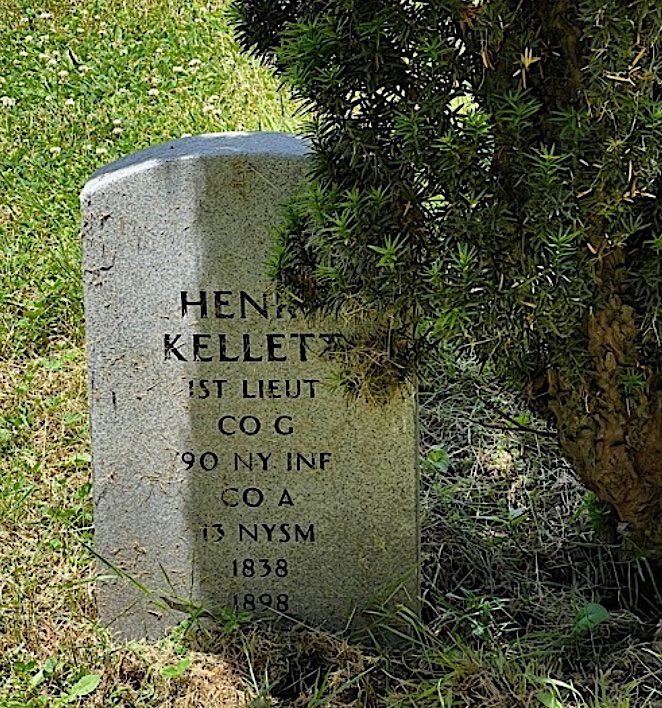
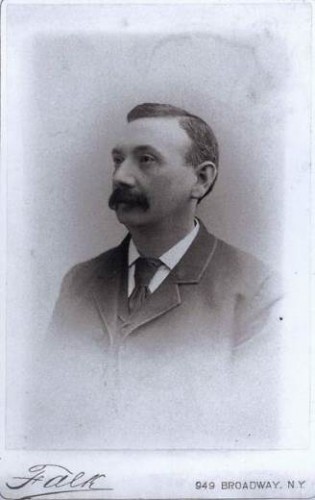
KELLEY, BENJAMIN FRANKLIN (1838-1902). Lieutenant, 9th Regiment, New York State Militia, Company F; private, 83rd New York Infantry, Company F. Kelley was born in Dublin, Ireland, and immigrated to the United States in 1853. He enlisted as a private at New York City and mustered into the 83rd on May 27, 1861, and was discharged for disability on June 26, 1862. He also served in the 9th New York Militia.
During his lifetime, he was a machinist, inventor, and traveling salesman, eventually becoming a manufacturer of hot water service heaters. As per his third great-grandson, Daniel Renz, who is preparing an application to join the Sons of Union Veterans, Kelley founded a water heater company that still exists to this day. It was initially founded in 1880 as Benjamin F. Kelley & Son in Brooklyn. The son, Harold Norwood Kelley, who is also buried at Green-Wood, was named as a successor to company ownership in Benjamin’s will. The company’s technological advance was feed-water heaters using tube bundles (replaceable coils). By 1892, about the time of the accompanying portrait, the business had reached markets in Philadelphia, Boston, and Chicago. The business also advertised and wrote a short article in the weekly journal, “The Electrical Age.” The company was renamed Patterson-Kelley Company in 1917 when his son-in-law Frank L. Patterson merged it with his own company. Patterson was married to Kelley’s daughter Grace; the Kelleys had another daughter Blanche. In 1927, Patterson-Kelley Company secured contracts to install their products in the White House during Calvin Coolidge’s presidency. The business relocated to Stroudsburg, PA sometime in the 1940s and is now a subsidiary of SPX Technologies, which is headquartered in Charlotte, North Carolina, and is listed on the New York Stock Exchange.
After the war, Kelley remained active in the Ulysses S. Grant G.A.R. Post#327. He also continued his involvement in the water-heating industry throughout his lifetime. Renz relates that his ancestor owned at least two patents approved by the U.S. Patent Office (both approved in 1902). As per Renz, the patents were for a feed-water heater (an improvement on an earlier patent on an unknown date) and for a drilling machine. The first mentioned patent was filed three months before Kelley’s death and approved 12 days after his death. The drilling machine application was approved about a month after his death. Both patents improved technologies in the water-heating business. He last resided at 875 Park Place in Brooklyn. After his death from septicemia, his widow, Mary Helen Kelley, applied for and was granted a pension in 1902, certificate 672,911. She died in 1919 and is interred with her husband. Section 198, lot 31083.
KELLEY (or KELLY), FREDERICK (1832-1887). Corporal, 158th New York Infantry, Company G. Of Canadian origin, Kelley enlisted as a private at Brooklyn on August 22, 1862, and mustered into the 158th New York six days later at which time he was promoted to corporal. He mustered out on June 30, 1865, at Richmond, Virginia. As per the census of 1880, he was a house painter. He last lived at 53 Pacific Street in Brooklyn. He died of phthisis (tuberculosis). In 1891, Hannah Kelley’s application for an widow’s pension was granted, certificate 307,026. Section 64, lot 4713, grave 155.
KELLEY, WILLIAM (1827-1878). Private, 1st New York Cavalry, Company M. Born in Newfoundland, Kelley enlisted as a private at New York City on August 1, 1861, and mustered into Company M of the 1st New York Cavalry on September 4. He re-enlisted on January 1, 1864. After he was severely wounded in the right leg at High Bridge, Virginia, on April 8, 1865, he was discharged for wounds at Hicks United States General Hospital, Baltimore, Maryland, on August 14, 1865. At the time of his death from phthisis, he resided in New York. Section 73, lot 4113.
KELLOCK, CORNELIUS M. (1842-1901). Private, 22nd Regiment, New York State National Guard, Company D. A New York City native, Kellock enlisted and mustered into the 22nd Regiment as a private on May 28, 1862, at New York City, and mustered out after three months on September 5. He filed for and received an invalid pension in 1891, certificate 894,992. His last address was at 2583 Eighth Ave, Manhattan. Upon his death from heart disease, his widow filed for a pension that was granted, certificate 540,718. Section 34, lot 20922, grave 6.
KELLY, RICHARD (1827-1868). Private, 53rd New York Infantry, Company I; 132nd New York Infantry, Company G. Born in Ireland, Kelly enlisted on June 29, 1862, at Suspension Bridge, New York, as a private, mustered into the 53rd New York on July 7, and was transferred into the 132nd New York on September 14, 1862, when the 53rd failed to complete its organization. His late residence was 224 West 27th Street in Manhattan. He died from consumption. Section 114, lot 8999, grave 1050.
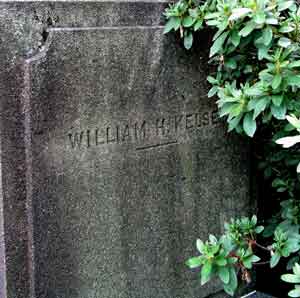
KELSEY, WILLIAM H. (1843-1862). Private, 84th New York (14th Brooklyn) Infantry, Company H. Kelsey enlisted at Brooklyn on August 23, 1862, and mustered into the 14th Brooklyn two days later. He was wounded on September 17 of that year during the Battle of Antietam, Maryland, and was discharged for his injuries on October 7 at Frederick, Maryland. That same day Sarah Kelsey, who may have been his mother, sent a telegram from Frederick to Walter Kelsey in Brooklyn: “Willey is worse—Come at once.” William died on his way home, in his mother’s arms. The telegram, his journal, his wallet, and the bullet that killed him have survived in a private collection. Section 170, lot 12952.

KELTON, JOHN (1837-1892). First corporal, 8th Regiment, New York State National Guard, Company G; private, 8th Regiment, New York Heavy Artillery, Company I. Born in New York, Kelton served for three months in 1861 with Company I of the 8th Regiment. The regiment mustered into federal service on April 23, 1861, at Washington, D.C., fought at First Bull Run, Virginia, and mustered out on August 2, 1861, at New York City. He also served for three months with Company G of the 8th Regiment in 1862. The 8th mustered in on May 29, 1862, served principally in Yorktown, Virginia, and mustered out at New York City on September 10, 1862. His gravestone appears to mistakenly state that he served in Company F.
According to the census of 1880, Kelton was a painter by trade. His application for an invalid pension was granted in 1890, certificate 716,597. He last lived at 118 Centre Street in Manhattan. Section 135, lot 27263, grave 959.
KENDALL, JAMES (1821-1874). Private, 4th New York Infantry, Company I. Of English birth, Kendall enlisted at New York City as a private on May 9, 1861, immediately mustered into the 4th, and deserted later that month on May 23 at New York City. He last resided in New York City. The cause of his death was dropsy. Section D, lot 20588.
KENDRICK, EDWARD E. (1840-1912). Adjutant, 10th New Jersey Infantry. After enlisting on September 21, 1861, he was commissioned into the Field and Staff of the 10th New Jersey as an adjutant that day, and was discharged on March 11, 1865. He was captured and taken as a prisoner of war on May 14, 1864, at Falling Waters, Maryland. His obituary in The New York Times stated that during the War he was “captured by Confederates and thrown into prison.”
Kendrick was one of the founders of the G.A.R. in New York City. In 1881, his application for an invalid pension was approved, certificate, 211,012. An article in The Times on September 14, 1890, highlighted the annual reunion of the First Brigade of New Jersey Volunteers, and indicated the passage of a resolution to compile a history of the brigade noting the appointment of Kendrick as one of the vice presidents of the committee to follow through on that effort. In civilian life, he was an accountant for the New York Central Railroad. His last residence was 135 West 125th Street in Manhattan. In 1913, Blanche Kendrick filed for a widow’s pension, application 1,000,812, but there is no evidence that it was certified. Section 65, lot 808.
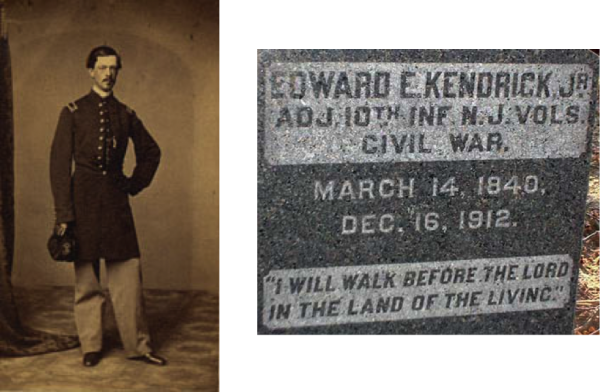
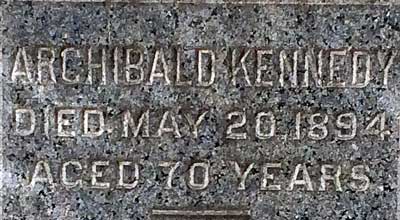
KENNEDY, ARCHIBALD (1824-1894). Private, 61st New York Infantry, Companies D and F. Born in Scotland, he enlisted at New York City as a private on August 15, 1861, mustered into Company D of the 61st New York on September 18, and was transferred to Company F on November 1, 1861. He was wounded at Fair Oaks, Virginia, on June 1, 1862, and deserted at Newark, New Jersey, on November 1 of that year. His last residence was 310 Greene Avenue, Brooklyn. According to an article in The New York Times on October 23, 1894, he left an estate worth $50,000. His will, signed five months before his death on May 19, 1894, was contested by his sister who argued that he was of unsound mind, an allegation disputed by his doctor in court. The cause of his death was meningitis. Section 7, lot 22601.
KENNEDY, EDWARD (1845-1898). Musician, 74th New York Infantry, Company E; 40th New York Infantry, Company G. A native of New York City, Kennedy enlisted at Good Hope, Maryland, as a musician, on September 7, 1861, and mustered into the 74th New York on October 17. At some point during his service in the 74th, he was reduced to ranks. After re-enlisting on January 1, 1864, he transferred into the 40th New York as a musician on August 3 and was discharged on June 27, 1865, at Washington, D.C. He joined the G.A.R. on June 9, 1873. His last residence was 843 Eighth Avenue in New York City. He succumbed to pneumonia. Section 127, lot 17931, grave 408.
KENNEDY, FRANCIS J. (1830-1883). Adjutant, 1st New York Mounted Rifles, Companies M and A; 4th New York Provisional Cavalry. After enlisting as a private on September 11, 1862, he mustered into Company M of the 1st New York Mounted Rifles, and rose steadily through the ranks. He became a corporal on October 1, 1862, commissary sergeant on March 8, 1863, quartermaster sergeant on May 11, 1863, and first sergeant on October 21, 1863. After re-enlisting on September 20, 1864, he was promoted to sergeant major on December 26 of that year, and commissioned a second lieutenant on January 31, 1865, effective upon his transfer to Company A. He was subsequently promoted to first lieutenant and adjutant on May 17, 1865. On September 6, 1865, he was transferred into the Field and Staff of the 4th New York Provisional Cavalry, a unit formed when the 1st Mounted Rifles was consolidated in July 1865, and from which he mustered out on November 29, 1865, at City Point, Virginia. His last residence was 64 Court Street in Brooklyn. His death was caused by hydropericardium, fluid buildup in the heart. Section 91, lot 2876.

KENNEDY, HUGH (1818-1879). Private, 155th New York Infantry, Company A; Veteran Reserve Corps. Of Irish origin, Kennedy enlisted as a private at New York City on September 30, 1862, and mustered into the 155th on November 18. On January 9, 1865, he transferred into the Veteran Reserve Corps. His last residence was 207 West 37th Street in Manhattan. Kennedy died of pneumonia. Section 197A, lot 28549, grave 1.
KENNEY (or KENNY), JOHN R. (1832-1891). Private, 127th New York Infantry, Company B. He enlisted on August 18, 1862, mustered in the next month on September 8, and remained with his regiment until it mustered out on June 30, 1865, at Charleston, South Carolina. He last lived at 74 Front Street in Manhattan. His death was attributed to phthisis. Section 122, lot 17806, grave 270.
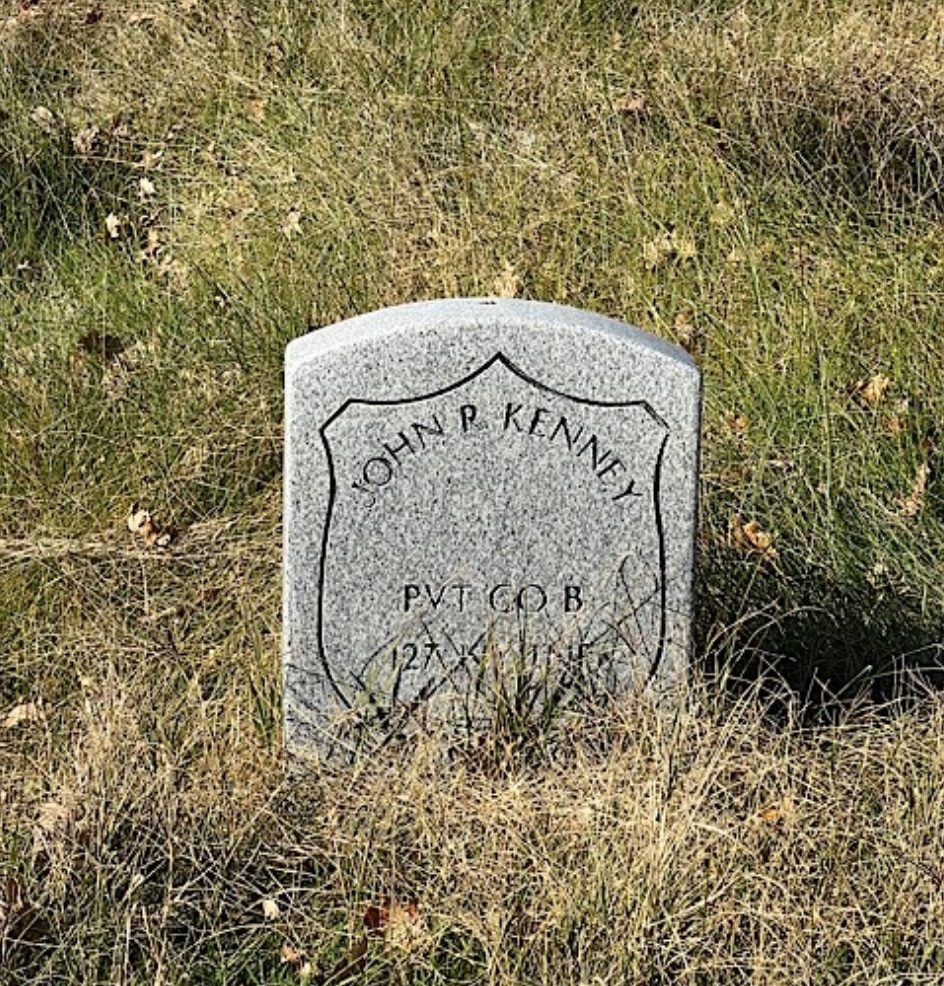
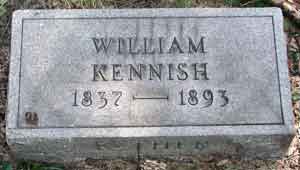
KENNISH, WILLIAM (1837-1893). Sergeant, 1st New York Engineers, Company H. Born in England, Kennish enlisted as a corporal on December 11, 1861, at New York City, and mustered that day into the 1st New York Engineers. On February 1, 1862, he was promoted to sergeant, and was discharged for disability at Beaufort, South Carolina, on October 27 of that year. His last residence was on Pacific Street in Brooklyn. He died from spinal meningitis. Section 172, lot 13432, grave 11.
KENT, HAMILTON (1811-1888). Private, 13th Regiment, New York State National Guard, Company I. Kent, who was born in New York State, enlisted at Brooklyn as a private on May 28, 1862. On that date, he mustered into the 13th Regiment at age 51. He mustered out three months later on September 12 at Brooklyn. According to the 1880 census, he was a sash-maker living in Brooklyn. As per his obituary in the Brooklyn Daily Eagle, he was a member of the Odd Fellows and the Society of Old Brooklynites. His last address was 657 Atlantic Avenue in Brooklyn. The cause of his death was bronchitis. Section 188, lot 16205, grave 3.
KENT, RICHARD A. (1842-1879). First lieutenant, 29th Illinois Infantry, Company B. Kent enlisted as a private and mustered into the 29th Illinois on September 12, 1862. He was promoted to second lieutenant on February 23, 1863, to first lieutenant on September 7, 1865 (not mustered), and mustered out on November 6, 1865. His last address was 440 West 24th Street, Manhattan. Pneumonia led to his death. Section 203, lot 22904.
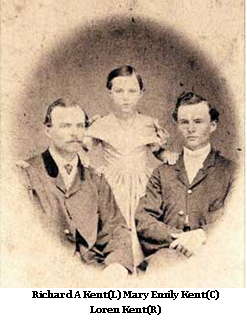
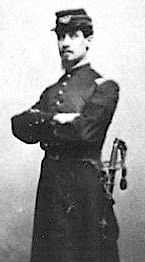
KENT, WILLIAM L. (1835-1900). Captain, 23rd Massachusetts Infantry, Company H. A native of Portland, Maine, Kent was resident of Boston, Massachusetts, and a bookkeeper by trade at the onset of the Civil War. After enlisting at Boston as a first lieutenant on October 8, 1861, he was commissioned into his company on December 4 of that year, and was promoted to captain on November 18, 1862. He was wounded at Drewry’s Bluff, Virginia, on May 16, 1864, and discharged for disability on February 24, 1865. His obituary in The New York Times confirmed his Civil War service and noted his rise to “captaincy” of his regiment. Active in numerous organizations, he was a member of the Loyal Legion, the Roanoke Society and the New England Society. He last lived at 194 Carroll Street in Brooklyn. His death was caused by nephritis. Section 154, lot 23134.
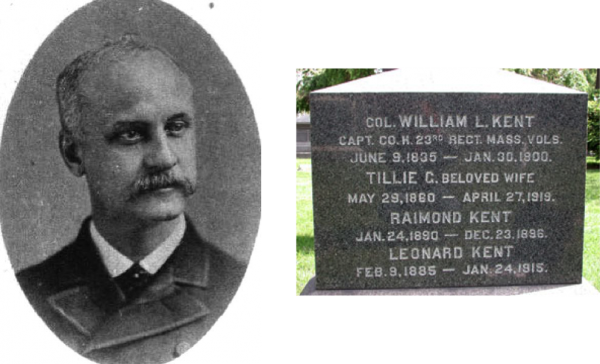
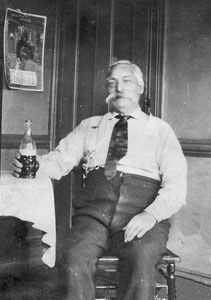
KENTANA, LOUIS (1842-1927). Private, 67th New York Infantry, Company G; 65th New York Infantry, Company B. Kentana, a Brooklynite by birth, enlisted there on July 30, 1861, and mustered into the 67th New York. His muster roll states that he was detached to the 1st Pennsylvania Artillery from September 1862 through February 1863 at which time he was detailed to pack the mule ammunition train in March and April 1863. He re-enlisted on December 25, 1863, at Brandy Station, Virginia, returned to the 67th and then transferred into the 65th in June 1864. Although his muster roll notes that he was absent without leave on July 20, 1864, and then listed as a deserter on that date, this was in error. His muster roll for December 31, 1864, states that he was hospitalized for six months with “confirmed excitability and palpitation of the heart.” He returned to the rolls in January 1865 and further muster rolls note that that the desertion was changed to absent/sick. Kentana was discharged with his company on July 17, 1865, at Hall’s Hill, Virginia. At the time of discharge, he was 5′ 5″ tall with brown eyes, light hair, light complexion and employed as a laborer.
At the time of the 1880 census, he is living with his wife Mary and three children and working as an expressman. According to his 1880 application for an invalid pension, he was wounded by a shell about four inches above the knee at the Battle of Malvern Hill, Virginia, on July 1, 1862, and was treated by the regiment surgeon. In addition, he stated that he suffered a gunshot wound in the right thumb at the Battle of the Wilderness, Virginia, in May 1864, and was treated at the Howard General Hospital in Washington, D.C., for about two months. However, a document from the Adjutant General’s Office of the War Department, dated January 10, 1882, states that there is no record of the “alleged” wounds. Although there is an apparent controversy about the wounds, he was awarded an invalid pension, certificate 352,564, a number that is recorded in a subsequent declaration for an invalid pension dated 1890. In 1912, Kentana’s communication related to his invalid pension notes that his honorable discharge from the 67th New York was lost at the Battle of the Wilderness and that the 67th was consolidated into the 65th New York at a later date.
As per the 1920 census, Kentana was living with his wife Emma and four children. According to his death certificate and his obituary in the Brooklyn Standard Union, he was a retired tinsmith. He last lived at 755 39th Street in Brooklyn. His death was attributed to senility. Shortly after his death in 1927, Emma Kentana, applied for and was awarded a widow’s pension of $30 a month, certificate 1,597,612. Section 135, lot 27263.
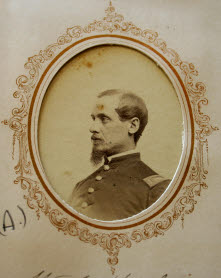
KENYON, RALPH WATSON (1831-1907). Captain, 47th Regiment, New York State National Guard, Company F. Born in Albany, New York, he enlisted at Brooklyn on May 27, 1862, was commissioned in immediately, and mustered out after three months of service on September 1 at Brooklyn. In 1904, he applied for and was granted an invalid pension, certificate 1,090,718. He was a member of the De Witt Clinton Commandery, Knights Templar, a branch of the Freemasons. His last residence was 43 Halsey Street, Brooklyn. He died of apoplexy. His widow, Julia Kenyon, who is interred with him, applied for a pension, application 881,881. Section 54, lot 9400.
KERBY (or KIRBY), CHARLES (1829-1893). First lieutenant, 176th New York Infantry, Company I; private, 84th New York (14th Brooklyn) Infantry, Company E. Originally from England, Kerby enlisted at Brooklyn on April 18, 1861, mustered into the 14th on May 23, and was discharged for disability the next month on June 18. He re-enlisted as a first lieutenant on December 19, 1862, at Flatbush, Brooklyn, and was commissioned into the 176th New York that same day. On June 23, 1863, he was taken prisoner of war at Brashear, Louisiana, was paroled on July 24, 1864, and mustered out on August 8, 1864, at New Orleans, Louisiana. He applied for and received an invalid pension in 1885, certificate 356,686. His last address was 411 Putnam Avenue, Brooklyn. Shortly after his death from rheumatism in 1893, Jane Kerby applied for and was granted a widow’s pension, certificate 385,252. Section 195, lot 28468, grave 2.

KERR, DAVID (1830-1878). First lieutenant, 37th New York Infantry, Company B. Born in Ireland, Kerr enlisted as a first lieutenant on May 9, 1861, at New York City. He was commissioned into the 37th on June 7, and was discharged on July 8 of that year. Kerr last resided at 232 West 38th Street in Manhattan. Bright’s disease was the cause of his death. Section 17, lot 17245, grave 731.
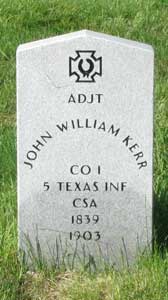
KERR, JOHN WILLIAM (1839-1903). Adjutant and first lieutenant, 5th Texas Infantry, Company I, Confederate States of America. Born in Greensville County, Virginia, Kerr attended Virginia Military Institute (V.M.I.), entered service at Washington County, Texas, and was elected second lieutenant in the Confederate Army in the 5th Texas Infantry on August 3, 1861. He was elected first lieutenant on October 10, after he was listed as being on leave and absent since October 7. Subsequently, the muster rolls show that he was present and promoted to first lieutenant on October 24, 1861. After a promotion to adjutant on August 1, 1862, Kerr served on the staff of General J. B. Robertson as lieutenant assistant inspector general beginning October 22 of that year. He was stationed near Chattanooga, Tennessee, in September-October 1863, and was promoted to brigade inspector on December 3, 1863. Kerr later served with General John Gregg as captain and assistant inspector general in 1864. After the War, he was a merchant in Brooklyn. He last lived at 35 St. Marks Avenue in Brooklyn. Kerr died from endocarditis. Section 15, lot 17263, grave 2444.
KERR, ROBERT (1839-1865). Private, 11th New York Cavalry, Company A. Born in New York State, Kerr enlisted on January 3, 1862, at New York City, as a private, and mustered immediately into the 11th New York Cavalry. He mustered out of service at Baton Rouge, Louisiana, on January 16, 1865. His last residence was 264 West 27th Street, Manhattan. Section 82, lot 2037.

KERR, WILLIAM (1819-1872). Private, 145th New York Infantry, Company C. A native of Ireland, Kerr enlisted at New York City as a private on August 15, 1862, mustered into the 145th New York on September 11, and deserted later that same month on September 23 at Staten Island. His last address was 434 West 28th Street in Manhattan. Bright’s disease claimed his life. Section 176, lot 21204.
KERRIGAN, JOSEPH AMBROSE (1832-1879). Examining surgeon, United States Volunteers. A New York native, Kerrigan was a graduate of St. John’s University, class of 1852, and the College of Physicians and Surgeons, New York City, class of 1858. During the Civil War, Kerrigan was an examining surgeon for the U.S. Volunteers. In this capacity, he was at the center of a controversial case. As per Section 1261 of Army Regulations in 1861, his responsibility was as follows:
In passing a recruit, the medical officer is to examine him stripped to see that he has free use of all of his limbs, that his chest is ample, that his hearing, vision and speech are perfect, that he has no tumors, or ulcerated or extensively ciciatrized legs, no rupture or chronic cutaneous affectations, that he has not received any contusions or wound of the head that may impair his faculties, that he is not a drunkard, is not subject to convulsions and has no infectious disorder, nor any other that may unfit him for military service.
Kerrigan was tried for violation of these recruiting regulations between November 28 and December 7, 1862. During that short time span, he passed four French sailors for enlistment who were drunk and had no understanding of what they were doing and two black men who were unfit because of age, had no understanding of why they were being examined, and received no explanations from Dr. Kerrigan. At the trial, Vincent Ruelland, one of the sailors, testified, with the help of an interpreter. Ruelland said that he had no recollection of the examination but woke up with enlistment papers in his hand. Ferdinand de la Hay, a French-speaking recruiting officer, countered on the witness stand that he was called to assist some Frenchmen who wanted to enlist and needed help in filling out the paperwork. De la Hay went on to say that Kerrigan was the examining doctor at Lafayette Hall where General Francis Spinola (see), who was recruiting for the 5th New York, was headquartered. De la Hay observed Kerrigan perform the examination according to regulations, escorted the Frenchman to the muster in station, and saw the recruit receive his bounty. He swore that the recruit was sober at the time he counted out his money and swore that Kerrigan gave thorough exams and was considered a “hard case” by recruit brokers.
Anthony Riker, the first black man who testified, thought that he was going to be hired to take care of the colonel’s horse. Riker, who was 63 years old with a lame ankle and bad back, was asked a simple question, “Which end of the pencil is up,” and then told that he had passed the vision exam. He swore that Kerrigan gave him a cigar and a drink and before he knew it, he was signed up. He went on to say that he could not write but someone took the pen to sign his name, that he was given only $14 of the $50 allocated for clothing and ultimately, and was discharged after a former employer acted on his behalf. The other black man, Joseph White, who was 48 years old and a waiter at the Metropolitan Hotel, was approached on the street and told that he was needed as a hostler to take care of horses. He was unknowingly led into Lafayette Hall, told to strip, given a cursory exam by Kerrigan, and deemed a soldier. He attested that he had a broken finger, tried to serve in a colored regiment under General David Hunter in Port Royal, South Carolina, could not tolerate the sun and was discharged and declared unfit for duty. Illiterate, he was given a pen, but another signed for him. Afterwards, he was given $40 of the $50 allocation for clothing, and sent to training camp on Riker’s Island. A letter from General William Tecumseh Sherman verifying the good character of the witness was admitted in evidence over Kerrigan’s lawyer’s objections.
Kerrigan’s witnesses were his colleagues at work including Dr. Alexander B. Mott (see) all of whom considered the doctor to be honest and reliable. Kerrigan, speaking on his own behalf, called the prosecution’s witnesses “unreliable liars.” On March 9, 1864, as per General Order No. 18, Department of the East, New York City, Kerrigan was found guilty of admitting into service two of the witness (Ruelland and Riker), acquitted of other charges, and disqualified from ever holding the office of surgeon under the United States Government as indicated by the recommendation of the judge advocate general. Two years later, a lawyer, Nelson Taylor, wrote to Secretary of War Edwin Stanton asking that Dr. Kerrigan’s administrative disability be removed; the request was granted. He last lived on West Street in Hoboken, New Jersey, where he died from cirrhosis. Section 29, lot 11475.
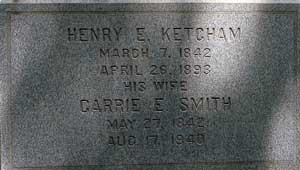
KETCHAM, HENRY E. (1842-1893). Corporal, 18th New York Infantry, Company D. Ketcham was born in Middletown, New York. After enlisting there as a private, on April 30, 1861, Ketcham mustered into the 18th New York on May 17. He was promoted to corporal on December 9, 1862, and mustered out with his company on May 28, 1863, at Albany, New York.
Ketcham’s obituary in the Middletown Daily Times on April 27, 1893, reported that he worked in a grocery store in Goshen, New York, as a young man before relocating to New York City where he was a printer and engraver working for James Everdell. He and two other employees later bought the establishment from Everdell; the establishment prospered and was the largest printing plant in the world at the time of Ketcham’s death. That obituary also noted that Ketcham and his family spent most summers in his hometown. As per his obituary in the New York Herald, his funeral took place at St. John’s Methodist Episcopal Church at Bedford Avenue and Wilson Street in Brooklyn. The photo of Ketcham seen here was included in a booklet distributed at a memorial service for him at the Royal Arcanum Hall at Bedford and Fulton Avenues in Brooklyn on May 22, 1893. A descendant gave the photo to Ryan A. Conklin, a researcher and author of The 18th New York in the Civil War. Ketcham’s last residence was 43 Jefferson Avenue in Brooklyn. He had been ailing for a few months before his death. Section 171, lot 22035, graves 2 and 3.

KETCHUM, JR., JOEL (1838-1887). Private, Hampton’s Legion, South Carolina Cavalry, Company B; 2nd South Carolina Cavalry, Company K, Confederate States of America. Originally from South Carolina, he was living in Charleston according to the 1850 census and in Greenville in 1860. Ketchum enlisted at Greenville as a private on June 6, 1861, mustered in eight days later, and initially served in the cavalry of Hampton’s Legion, a South Carolina Confederate unit comprised of infantry, artillery, and cavalry. The company muster roll at the time of his enlistment indicates that he traveled 144 miles to rendezvous at Columbia, South Carolina, had a horse valued at $125 and equipment worth $30. When the Army of Northern Virginia was reorganized in 1862, Hampton’s Legion was broken up and the cavalry was expanded into the 2nd Carolina Cavalry. According to the company muster roll for May and June of 1863, he was paid $24.40 for use of his horse. The muster roll for November and December 1864 shows that he was absent and sick in a hospital dating to October 1864. His last residence was The House of Incurables in the Fordham section of the Bronx where he died of epileptic convulsions. Section N, lot 18030.
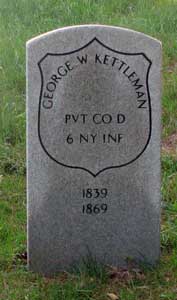
KETTLEMAN, GEORGE W. (1839-1869). Private, 6th New York Infantry, Company D. A New Yorker by birth, Kettleman enlisted as a private at New York City on April 25, 1861, enlisted into the 6th New York five days later, and mustered out at New York City on June 25, 1863. His last residence was 246 West 16th Street in Manhattan. His death was attributed to peritonitis. Section 43, lot 10832.
KETTLEMAN, JOHN W. (1835-1884). First lieutenant, 8th Regiment, New York State National Guard, Company I. He enlisted and mustered into the 8th National Guard at New York City on June 17, 1863, and mustered out with his company after 30 days on July 23 at New York City. Kettleman’s last address was 463 West 79th Street in Manhattan. He died of heart disease. Section 112, lot 5473.

KEW, JACOB HARRIS (1830-1913). Private, 22nd Regiment, New York State National Guard, Company E. A native of Bandon in County Cork, Ireland, he was 5’6½” and settled in the United States in 1859. After he enlisted as a private at New York City on May 28, 1862, he immediately mustered into the 22nd Regiment and mustered out with his company on September 5 of that year. He was employed at one point as a stair-builder and last lived at 492 Greene Avenue in Brooklyn. Kew succumbed to pneumonia. Section 206, lot 21347.
KEYES, RICHARD (1821-1867). Private, 53rd New York Infantry, Company D; 162nd New York Infantry, Company F. Born in Ireland, Keyes enlisted at New York City as a private on July 29, 1862, and mustered into the 53rd New York on August 22 of that year. He was transferred into Company F of the 162nd New York on September 15, 1862, when the 53rd failed to complete its organization. His last residence was on Oak Street in New York City. His death was attributed to ascites, a condition of fluid buildup in certain body cavities. Section A, lot 8100, grave 645.

KEYMER (or KEUMER), FRANCIS H. (1833-1864). Private, 139th New York Infantry, Company A. Keymer, who was born in Long Island, New York, enlisted at Brooklyn as private on August 20, 1862. On September 9, 1862, he mustered into the 139th New York and subsequently died from a unrecorded disease on February 28, 1864, at Portsmouth, Virginia. Section 62, lot 6432.

KEYMER, GEORGE (1838-1915). Corporal, 139th New York Infantry, Company A. Born on Long Island, New York, and following a seafaring life prior to the Civil War, Keymer enlisted at Brooklyn as a private on August 28, 1862, mustered into the 139th the next month on September 9, was promoted to corporal on August 6, 1864, and mustered out at Richmond, Virginia, on June 19, 1865. He participated in numerous Virginia battles, including Second Williamsburg, Baltimore Crossroads, Bottom’s Bridge, Charles City Court House, Bermuda Hundred, Drewry’s Bluff, Cold Harbor, Petersburg, Mine Explosion, and the capture of Richmond.
After the Civil War, Keymer moved to Brooklyn where he was in the construction business as a house framer. He was a member of G.A.R.’s Ulysses S. Grant Post #327, served in the Relief Guard at Grant’s funeral, and belonged to the 139th Regiment Veteran Association. His application for an invalid pension was granted in 1892, certificate 880,176. In 1895, he successfully brought a suit against the Civil Service Commission that was settled in his favor after applying for a job as a messenger in the City Auditor’s Office. The ruling gave preference to Civil War veterans in filling positions below a specified pay level ($4 per day). On January 22, 1896, an article in The New York Times indicated that the ruling was overturned placing veterans on equal footing with other examinees for civil service positions. As per his obituary in the Brooklyn Daily Eagle, members of the Grant Post of the G.A.R. were requested to attend his funeral in uniform, “officers without side arms.” He last lived at 252 Monroe Street in Brooklyn. His death was attributed to nephritis. M. Sophia Keymer applied for and received a widow’s pension in 1915, certificate 792,110. Section 94, lot 1188.

KEYSER, ANDREW (enlisted as KING, GEORGE) (1842-1911). Private, 15th Connecticut Infantry, Company G; ordinary seaman, United States Navy. A New York native, Keyser was borne on both the infantry and Navy rolls as George King. A resident of Middletown, Connecticut, he first served in Company G of the 15th Connecticut from March 8, 1864, until he transferred into the United States Navy on as an ordinary seaman on May 17. While in the Navy, he served onboard USS Minnesota, enlisting at Hampton Roads, Virginia, and then the USS Malvern. According to the enlistment roll for the Navy, he was listed as a sailor who was 5′ 10¾” tall with blue eyes, brown hair and a dark complexion.
In 1891, Keyser applied for an invalid pension based on his service in the Union Army, application 1,040,474, but there is no certification number. He received a pension from the Navy, certificate 29,473. His government-issued gravestone incorrectly records his service as a private in Company G of the 15th New York. His last residence was 607 Woodward Avenue in Ridgewood, Queens. His death was caused by arteriosclerosis. In 1912, Margaret Keyser, who is interred with him, applied for and received a widow’s pension, certificate 886,998. Section 17, lot 17245, grave 926.

KID, CHARLTON B. (1835-1882). First assistant engineer, United States Navy. Born in Philadelphia, Pennsylvania, Kid entered the Navy as a third assistant engineer on May 21, 1857, rose to second assistant engineer on August 2, 1859, and to first assistant engineer on February 1, 1862. He resigned on December 30, 1867. His last residence was 271 West 11th Street in Manhattan. His death was attributed to diabetes. Section 2, lot 5499, grave 1659.
KIEFER (or KEEFER), MICHAEL (1838-1874).Private, 66thNew York Infantry, Company E. Kiefer’s death certificate reports that he was born in New York to German-born parents. As per his muster roll, which notes that he was borne on the rolls as both Michael Kiefer and Michael Keefer, he enlisted as a private at New York City on October 25, 1861, and mustered into Company C of the 66th New York that same day. It also records that he deserted on November 10, 1861, but that is likely incorrect. The muster roll notes that he was discharged on November 5, 1864, at the expiration of his service.
His death certificate records his name as Michael Keefer. The document reports that he was single, employed as a truckman, and living in New York City for two years and six months. The physician, who signed the certificate, attests that he treated Michael from September 8, 1873, through April 5, 1874, the day before his death. It reports the cause of death as pulmonary phthisis (tuberculosis) and lists an address on Court Street. Green-Wood’s records note him as single and last living on Leonard Street in Manhattan. Lot 1594, grave 240.
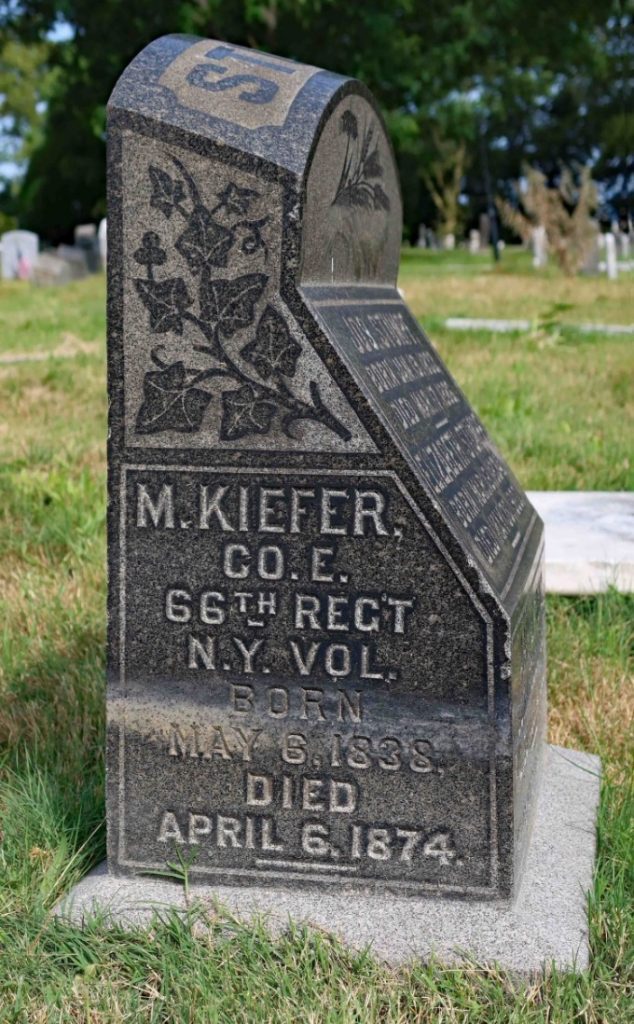
KIERNAN, JAMES LAWLOR (1837-1869). Brigadier general, United States Volunteers; surgeon, 6th Missouri Cavalry; assistant surgeon, 69th Regiment, New York State Militia. A native of Mount Bellew in Galway County, Ireland, and son of a surgeon in the Royal Navy, he studied at Dublin’s Trinity College. He immigrated to New York City around 1854 and graduated from the medical department of the University of New York in 1857. After teaching in the public schools and serving as editor of the New York City Medical Press from 1859 through 1861, he joined the 69th New York State Militia on April 20, 1861, as its assistant surgeon, and resigned on May 22 of that year at Fort Corcoran, Virginia. On March 1, 1862, he re-enlisted as a surgeon and was commissioned immediately into the Field and Staff of the 6th Missouri Cavalry.
At the Battle of Pea Ridge, Arkansas, on March 7, Kiernan was wounded in the right leg when a musket ball fractured his tibia. He was hospitalized until April 30 of that year. At Port Gibson, Mississippi, on May 6, 1863, he was shot in the left lung, thrown from his horse and captured, but managed to escape. He was hospitalized at the U.S. General Hospital at Grand Gulf, Mississippi, until June 2. On August 1, 1863, he was appointed brigadier general of United States Volunteers, contracted malaria that fall, and resigned on February 1, 1864, due to failing health. After the War, he was consul to Chin Kiang, China, and a surgeon in the United States Pension Bureau. His death was attributed to congestion of the lungs, apparently resulting from the wound that he suffered at Port Gibson; the bullet had remained in his lung. He last lived at 237 West 33rd Street in Manhattan. Section 66, lot 19229.
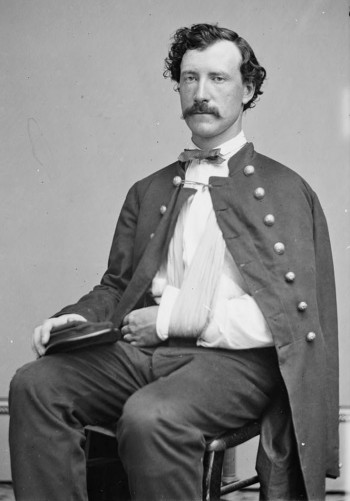
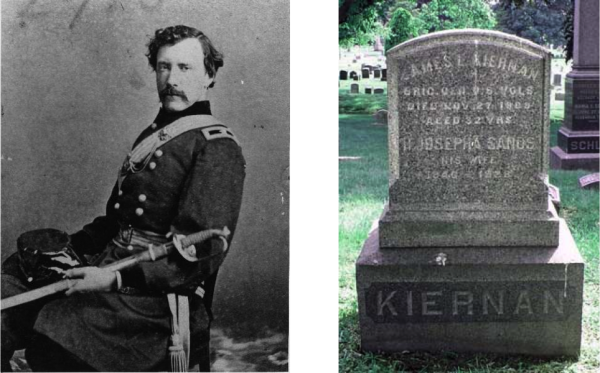
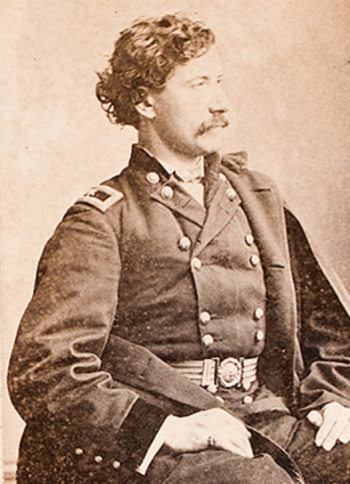
KIES, CHARLES (1845-1919). Private, 197th Pennsylvania Infantry, Company B. A native of Bloomingdale, New York, Kies enlisted as a private on July 16, 1864, mustered into the 197th Pennsylvania the same day, and mustered out at Philadelphia, Pennsylvania, on November 11, 1864. His pension application was granted in 1916, certificate 1,180,127. His last residence was 2416 Gravesend Avenue in Brooklyn. Apoplexy caused his death. Elizabeth Kies, who is interred with him, was awarded a widow’s pension in 1919, certificate 875,078. Section 203, lot 35316, grave 2.

KIESSLING, EUGENE (1847-1867). Musician, 90th New York Infantry, Company B. Born in Germany, Kiessling enlisted at age 15 as a musician at Key West, Florida, on May 27, 1862. On that date, he mustered into the 90th New York, serving until he mustered out on June 3, 1865. His last residence was 201 Navy Street in Brooklyn. He died from tuberculosis. Section 103, lot 21082.
KILBURN (or KILBOURN), HENRY FRANKLIN (1844-1905). Private, 52nd Massachusetts Infantry, Company E. Kilbourn was born in New York State. A farmer and resident of Ashfield, Massachusetts, he enlisted as a private of September 1, 1862, and mustered into the 52nd Massachusetts on October 11. He mustered out on August 14, 1863, at Camp Miller in Greenfield, Massachusetts.
After Kilburn studied architecture in Northampton, Massachusetts, he relocated to New York City in 1868. A well-known architect, he designed numerous churches in Manhattan including the West End and West Park Presbyterian Churches, the Mt. Moriah Baptist Church, and the Durland Riding Academy (now a production studio for ABC). He also created new facades on many row houses and brownstones converting them from residential to commercial use. Kilburn, who had a studio at 156 Fifth Avenue in Manhattan, was a fellow of the American Institute of Architects, and a member of the Architectural League, the Larchmont Yacht Club, and the New England Society. According to his obituary in The New York Times, he belonged to the Washington Post #103 of the G.A.R. An application for a minor’s pension was granted to his child in 1907, certificate 634,442. He last lived at 127 East 15th Street, Manhattan. Section 180, lot 14146, grave 11.
KILEY, JAMES (1838-1875). Sergeant, 33rd New York Infantry, Company F. Kiley, a New York State native, enlisted on May 13, 1861, at Nunda, New York, as a sergeant. He mustered into his company nine days later and mustered out on June 2, 1863. He last resided at 124 19th Avenue in Brooklyn. He succumbed to phthisis pulmonalis. Section 197, lot 29768, graves 10 and 11.

KILGOUR, JOHN (1828-1897). Sergeant, 62nd New York Infantry, Company A. Born in Scotland, Kilgour enlisted as a private at New York City on April 30, 1861, mustered into the 62nd New York on June 30, and was promoted to corporal on October 18 of that year. After re-enlisting on January 1, 1864, he rejoined his regiment and company. On May 5, 1864, he was wounded in action at the Battle of the Wilderness, Virginia. On January 1, 1865, he was promoted to sergeant, and mustered out of service on August 30, 1865, at Fort Schuyler, New York Harbor. In 1878, his application for an invalid pension was granted, certificate 157,832. His last residence was on South 2nd Street in Brooklyn. He died of consumption. His widow, Margaret Kilgour, applied for and received a pension, certificate 474,562. Section 190, lot 17621 grave 1.
KILTZ (or KILZ, KILS, KETZ), CONRAD (1848-1880). Landsman, United States Navy. Kiltz was born in Germany; his surname has numerous spellings on documents bearing his name. As per his wife’s application as an Army widow, he served as a landsman in the United States Navy from 1864 to 1866 aboard the USS Newbern, USS North Carolina, USS Chickopee, USS Mattabesett and the USS Vermont.
Records from the Presbyterian Church note that on February 10, 1873, Kiltz married Bertha Friedmann at the Madison Street German Presbyterian Church in New York City. His pension application notes that he also served as a private in Company F of the United States Cavalry from September 10, 1878 through August 5, 1880, when he was discharged for disability at Fort Totten, Washington, D.C. At the time of that enlistment, he was a tinsmith who was 5′ 8¼” tall with hazel eyes, dark hair and a fair complexion. The 1876 and 1880 New York City Directories list him as a tinsmith. Although he applied for a pension from the Army, using the alias of Conrad Ketz, application 412,371, he died before it was certified. As per his death certificate, which has a spelling of Kils, he was married; his occupation on that document is incorrectly listed as scientist. He last lived at 336 8th Street in Brooklyn. His death was attributed to cancer. In 1887, Bartha (Bertha) Kiltz applied for and received a widow’s pension, certificate 252,121. Lot 5499.
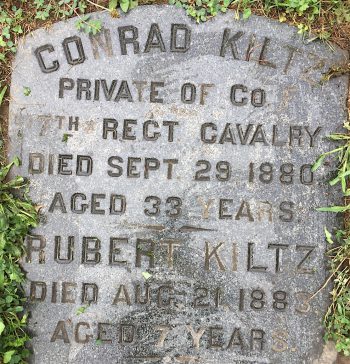
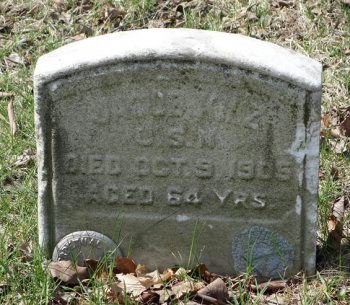
KILZ, JACOB (1841-1905). Rank unknown, United States Navy. Of German birth, Kilz enlisted in the United States Navy at New York City on September 2, 1863. A shoemaker at the time of his enlistment, he was 5′ 6½” tall with brown hair, blue eyes, a fair complexion and a mole on his thigh. As per his Navy record, he served on the USS Paul Jones, USS New Hampshire, USS Patapsco, USS Laburnam, USS Chattanooga, and the Receiving Ship Philadelphia. He was discharged on June 16, 1866. Kilz received a pension from the Navy, certificate 21,293. He is listed as an engineer on the census of 1870. He last lived at 340 17th Street in Brooklyn. Kilz died at Jersey City, New Jersey, in a drowning accident. His wife applied for and received a widow’s pension from the Navy, certificate 964,615. Section 203, lot 27139, grave 2.
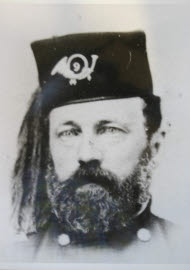
KIMBALL, EDGAR ADDISON (or ALLEN) (1821-1863). Lieutenant colonel, 9th New York Infantry. Born in Concord, New Hampshire, he trained as a printer and was the proprietor and editor of the Age, a liberal Democratic newspaper, published in Woodstock, Vermont. Appointed captain of infantry in the United States Army in 1847, he served with distinction at Contreras and Churubusco during the Mexican War, and received General Bravo’s surrender. For his service he was brevetted major. As per his widow, Lucretia Kimball’s pension application, number 34,790, they were married on November 1, 1849.
When the Civil War began, Kimball left his position as a journalist and was commissioned a major in a New York Zouave regiment. Pension information notes that he enlisted for two years on May 4, 1861, and was immediately commissioned that same date. After his unit, the 9th New York, overran the enemy’s works during the Battle of Roanoke Island, North Carolina, he was promoted to lieutenant colonel and given command of a regiment. His actions at Roanoke Island were praised by Brigadier General John G. Parke in his field report of February 8, 1862, describing the difficulties of navigating the swamps there necessitating that the 9th change its course, “This was done in gallant style, Major [Edgar Addison] Kimball taking the lead. The major was very conspicuous during the movement, and I take great pleasure in commending him to your favorable notice…”
Kimball fought at Antietam and Fredericksburg, only to be killed on April 12, 1863, by Colonel Michael Corcoran while he was camped near Suffolk, Virginia. One account was that Corcoran, trying to pass through the Union lines was stopped by Kimball, who demanded the countersign before Corcoran would be allowed to proceed. When Corcoran refused to give it, Kimball made a movement that Corcoran interpreted as threatening, and Corcoran shot him. Another version was that Corcoran and Kimball were rivals, and Corcoran either mistook, or pretended to mistake, Kimball for an assassin.
But by all accounts Kimball was a hero, and when his body was returned to New York City, it lay in state in the Governor’s Room of City Hall. As his coffin was removed to begin its journey to Green-Wood, a twenty-one gun salute was fired in City Hall Park. His permanent burial at the cemetery was postponed until the 9th New York returned to New York City from the front.
In his wife’s application for a widow’s pension, she stated that her husband was killed on April 12, 1863, by a “pistol shot wound at the hands of General Corcoran while in the discharge of his duty.” The Pension Bureau noted:
“…It is my opinion that the presumption in favor of Lt. Col. Kimball’s death in the line of duty is so strong as to entitle the widow to a decision in her favor. No court martial has been, or is likely to be, held on this subject, and it becomes my duty to decide on this claim without such investigation. I do so by giving the claimant the advantage of the reasonable presumption in her favor, and without assuming to give any opinion further than as her claim is directly affected. Admitted, December 3, 1863.”
Interment was on June 18, 1863. Post #100 of the G.A.R., in New York County, was chartered in 1871 and was named in his honor. Section 172, lot 14055.


